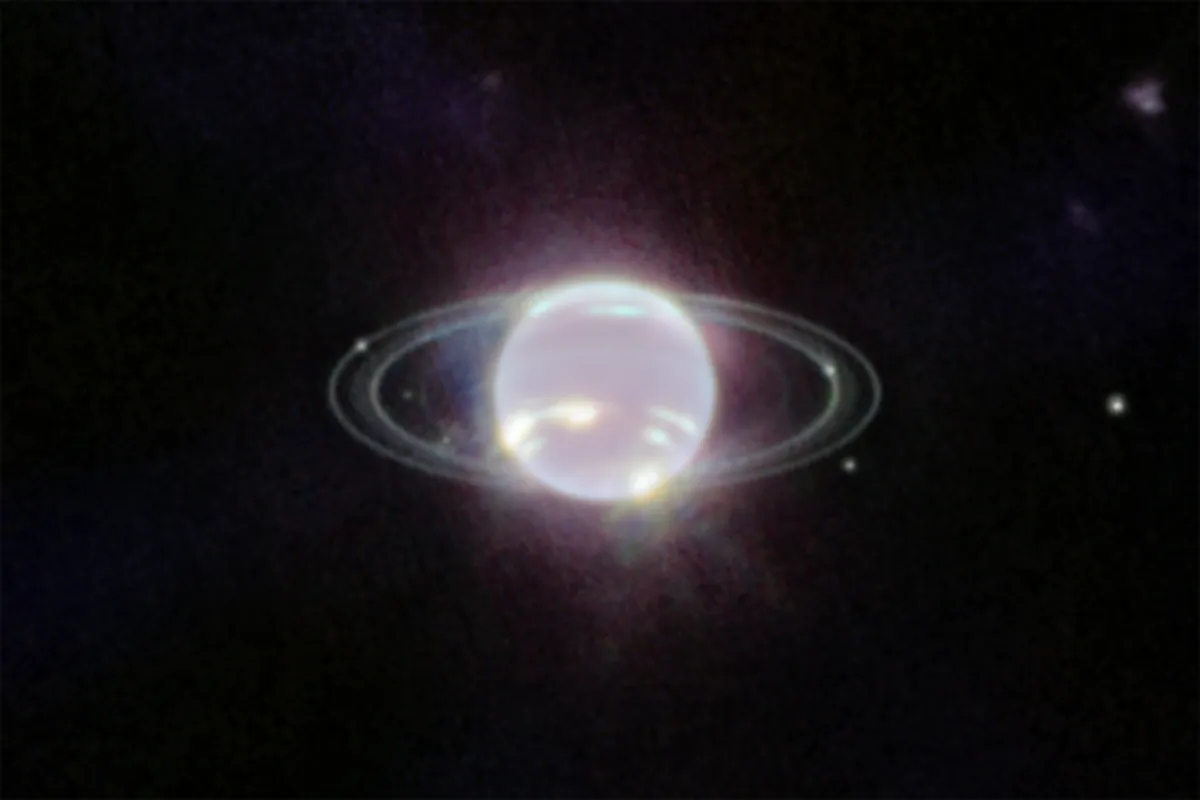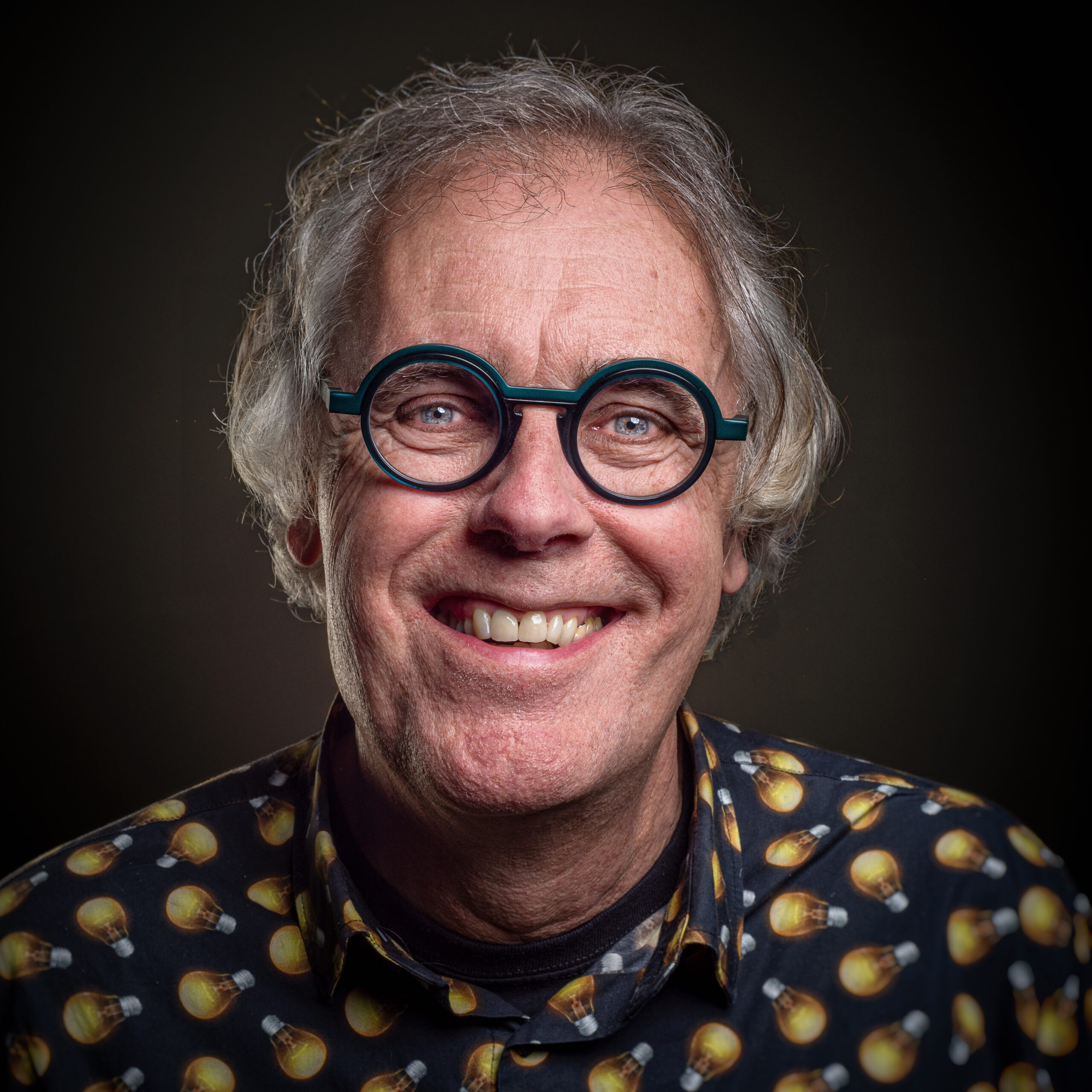These are the latest and best images captured by the James Webb Space Telescope.
After 25 years and over 10 billion US dollars, on Christmas Day 2021, the James Webb Space Telescope (JWST) was finally launched into space by a European Ariane 5 rocket.
With its 6.5-metre primary mirror and its tennis-court-sized sunshield, Webb had to be folded up to fit in the rocket’s fairing, only to be deployed step by step in the first two weeks of its mission.
On 12 July 2022, months of eager anticipation paid off, as NASA released the first full colour images of the cosmos captured by the James Webb Space Telescope.
Find out how James Webb Space Telescope will study galaxies, how James Webb Space Telescope will study exoplanets and what the James Webb Space Telescope looks like in space

In June 2025, astronomers announced a potential exoplanet orbiting distant star TWA 7 which, if confirmed, would be the first exoplanet discovered by the Webb Telescope.
Find out more in our story on TWA 7 b.
Einstein ring

This 'Einstein ring' is caused by light from a distant spiral galaxy being warped by the gravity of a foreground galaxy.
The effect is a type of gravitational lensing that happens because the mass of objects bends and distorts spacetime.
Find out more in our full story about Webb's Einstein ring image.
Lynds 483

In March 2025, Scientists released an image of outflows from two young protostars. The object is named Lynds 483 and Webb provided a unique view of the intricate structures of the outflows.
Find out more about Webb's Lynds 483 image
Arp 107

In September 2024 Webb released an image of Arp 107, the name given to two galaxies in the process of merging.
The merging is occurring between elliptical galaxy and a spiral galaxy, and Webb has given astronomers a unique view of the event.
Find out more about Webb's Arp 107 image
Serpens Nebula

In June 2024, astronomers captured this James Webb Space Telescope image of the Serpens Nebula, which shows shockwaves caused by jets from young stars colliding with cosmic gas and dust.
Top of the Horsehead Nebula

In April 2024, astronomers revealed an image showing the top of the 'mane' of the famous dark nebula known as the Horsehead Nebula.
Find out more about Webb's Horsehead Nebula image.
NGC 604

In March 2024, the Webb Telescope release an image of NGC 604, a star-forming region within the Triangulum Galaxy.
Webb's NIRCam and MIRI views of NGC 604 were able to reveal structures and objects that had not been seen in previous images of the region.
Find out more about Webb's image of NGC 604
Star cluster IC 348
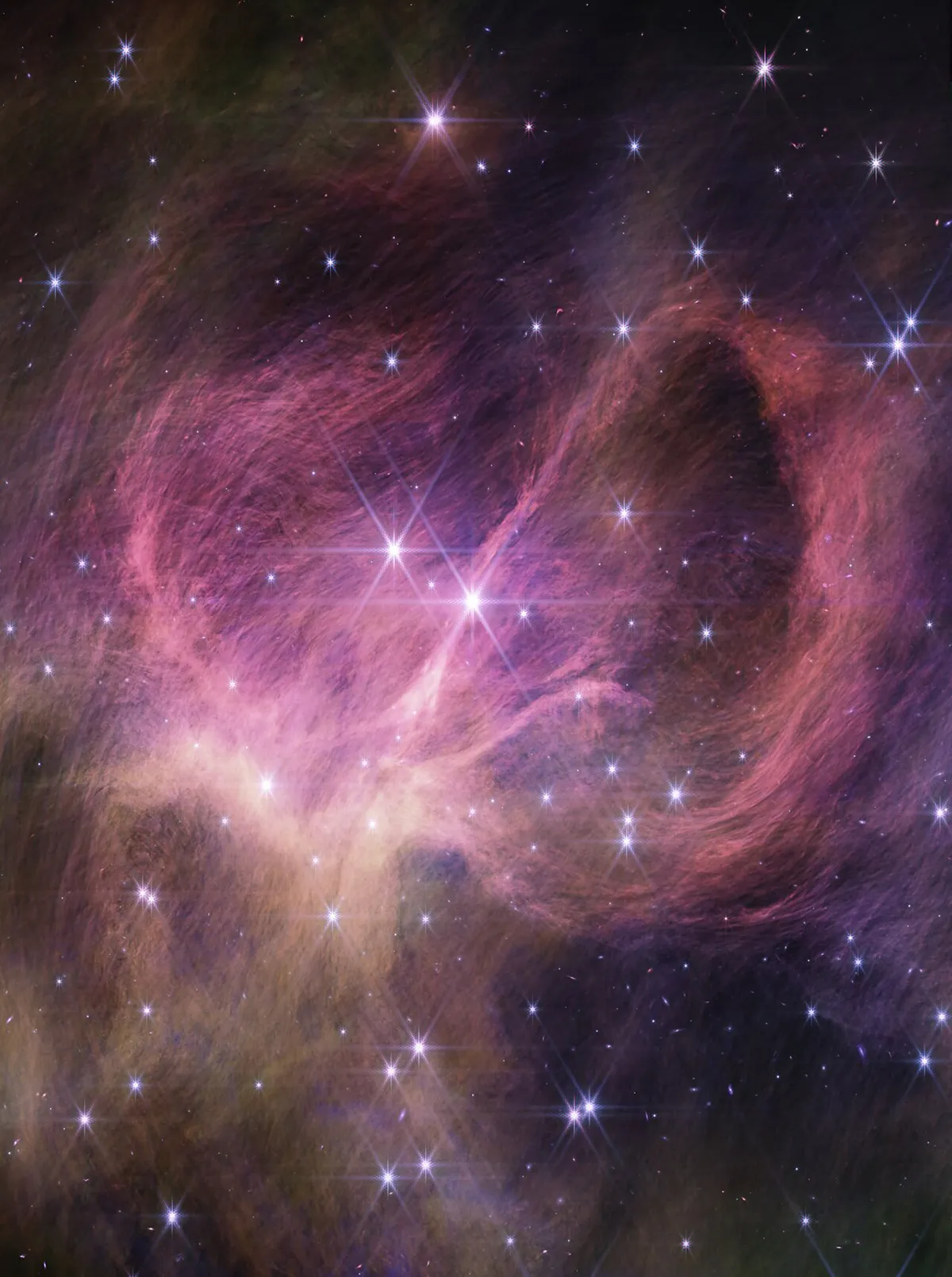
This view of young star cluster IC 348 was captured as part of Webb observations searching for tiny brown dwarfs.
Read more about Webb's IC 348 brown dwarf hunt
Cassiopeia A (NIRCam)
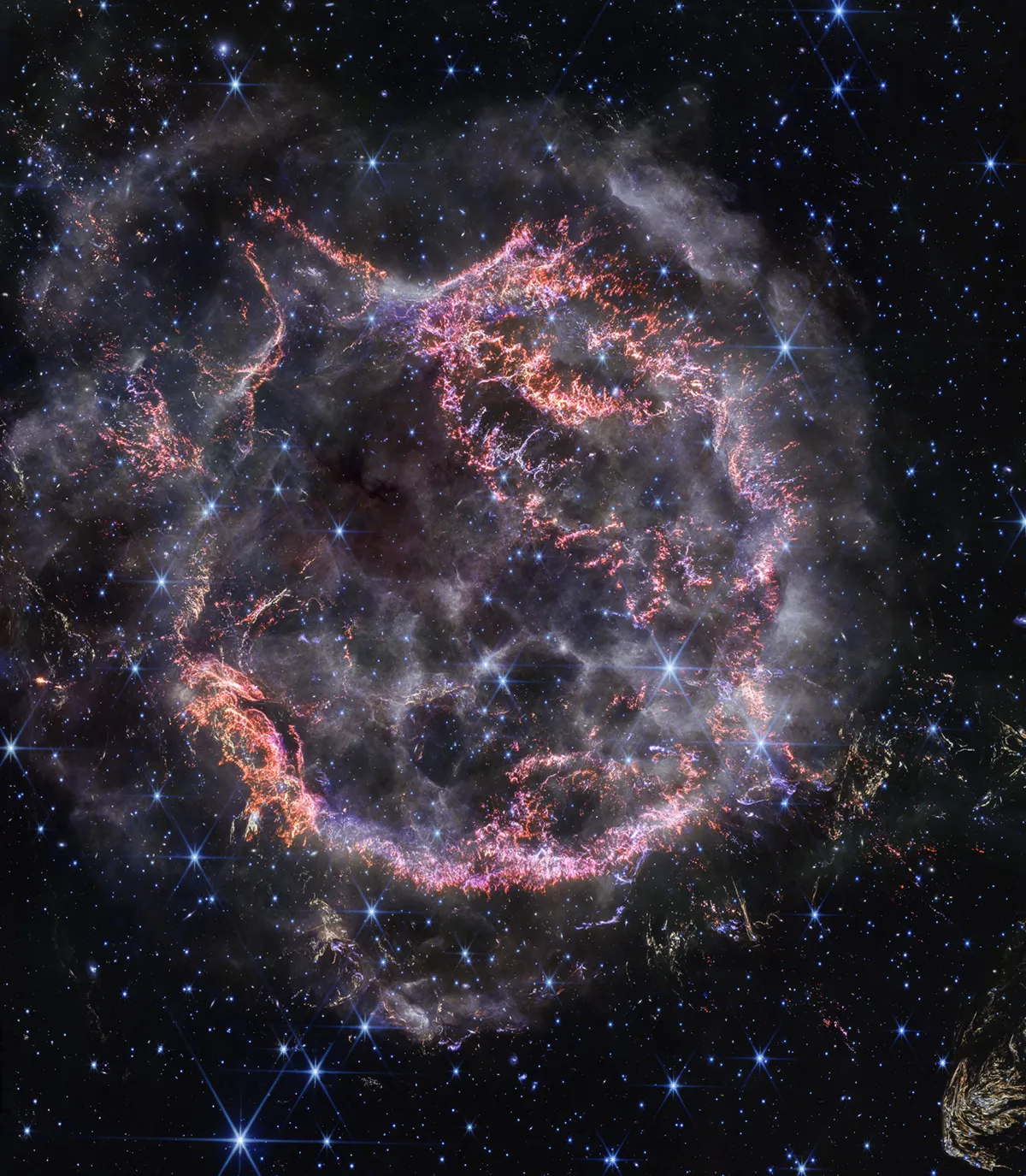
December 2023 saw the release of Webb's NIRCam image of Cassiopeia A (Cas A), an object known as a supernova remnant.
Read more about Webb's Cassiopeia A image
Christmas Tree Galaxy Cluster

November 2023 saw the release of this amazing Hubble/Webb composite, showing galaxy cluster MACS0416, known as the Christmas Tree Galaxy Cluster. It's a massive collection of galaxies bound by gravity 4.3 billion lightyears away.
Read more about the Christmas Tree Galaxy Cluster
The Crab Nebula

NASA, ESA, CSA, STScI, T. Temim (Princeton University)
In October 2023, the Webb Telescope released its amazing image of the Crab Nebula, revealing the web-like structure and ethereal dusty cavities of this supernova remnant like never before.
Get the full story with our article on the Webb Telescope's Crab Nebula image.
Herbig-Haro 211
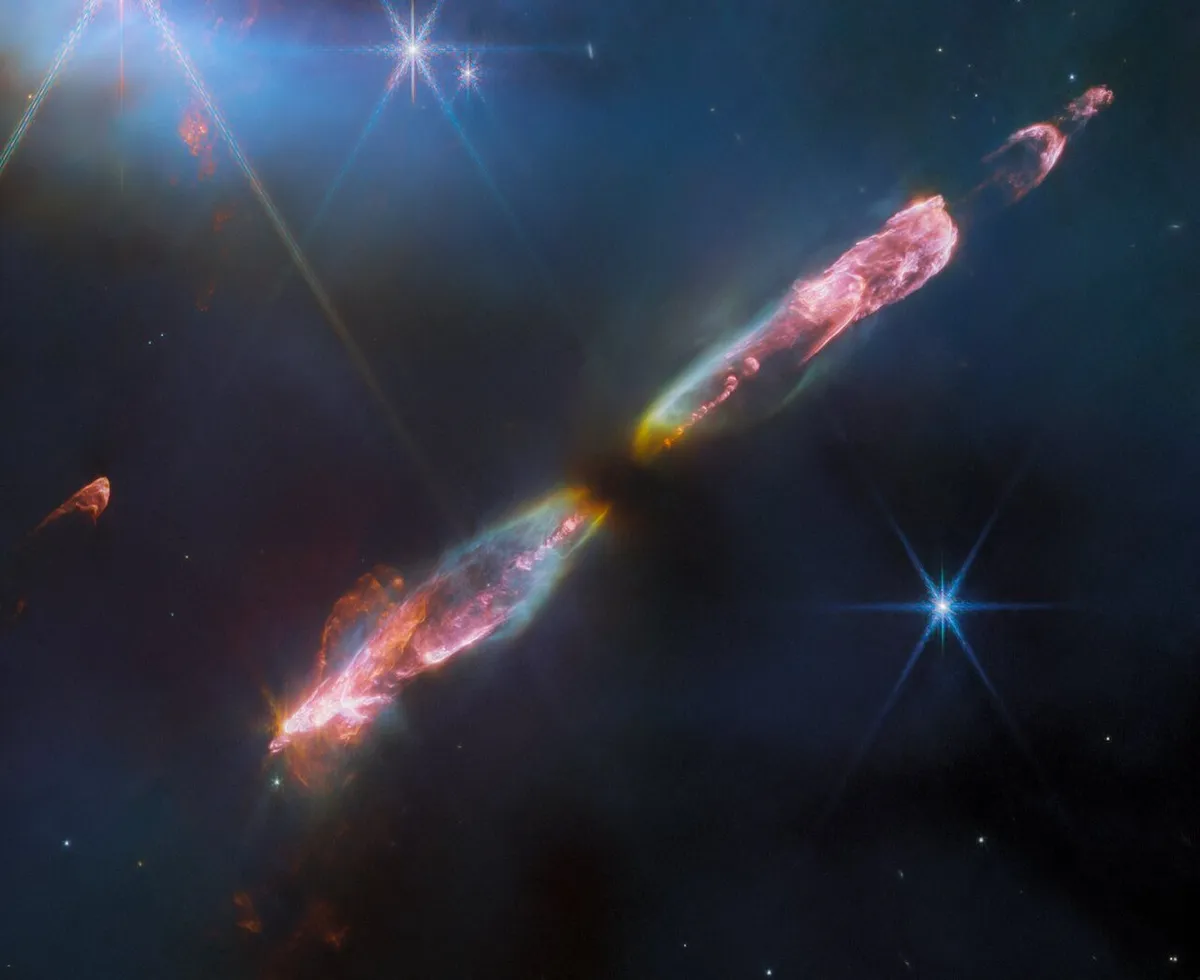
In September 2023, the James Webb Space Telescope captured an image of energetic jets shooting outwards into space from a newborn star 1,000 lightyears away.
Jets of gas are hurtling away from the star, colliding with cosmic gas and producing shockwaves.
The subject of the image is Herbig-Haro 211 (HH 211), in the constellation Perseus.
It is one of the youngest and nearest known protostellar outflows.
Read more about Webb's Herbig-Haro 211 image
The Ring Nebula
In August 2023 the James Webb Space Telescope released this spectacular image of the Ring Nebula.
The Ring Nebula is a favourite target for astrophotographers and observers alike, due to its striking appearance.
Read more about Webb's Ring Nebula image

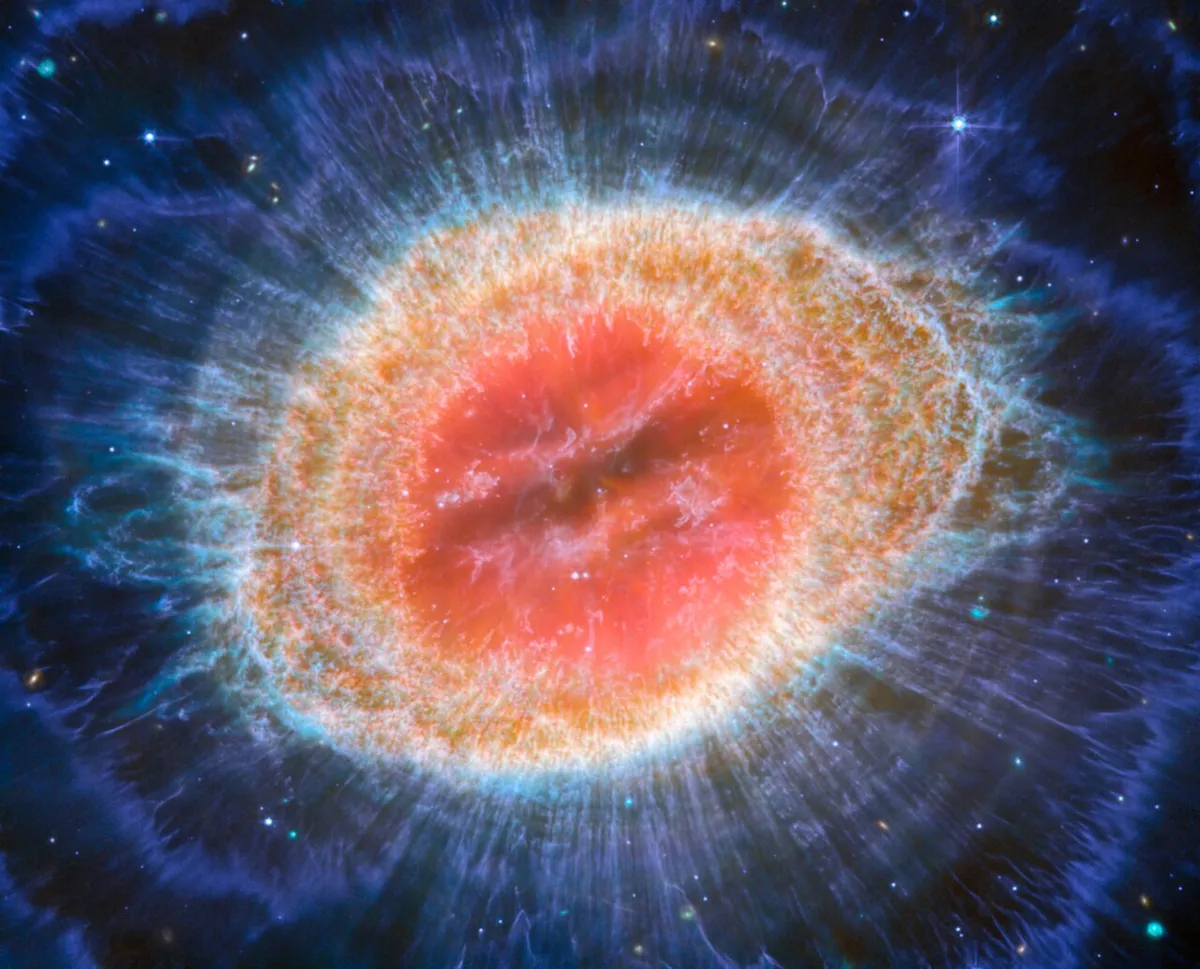
Rho Ophiuchi cloud complex
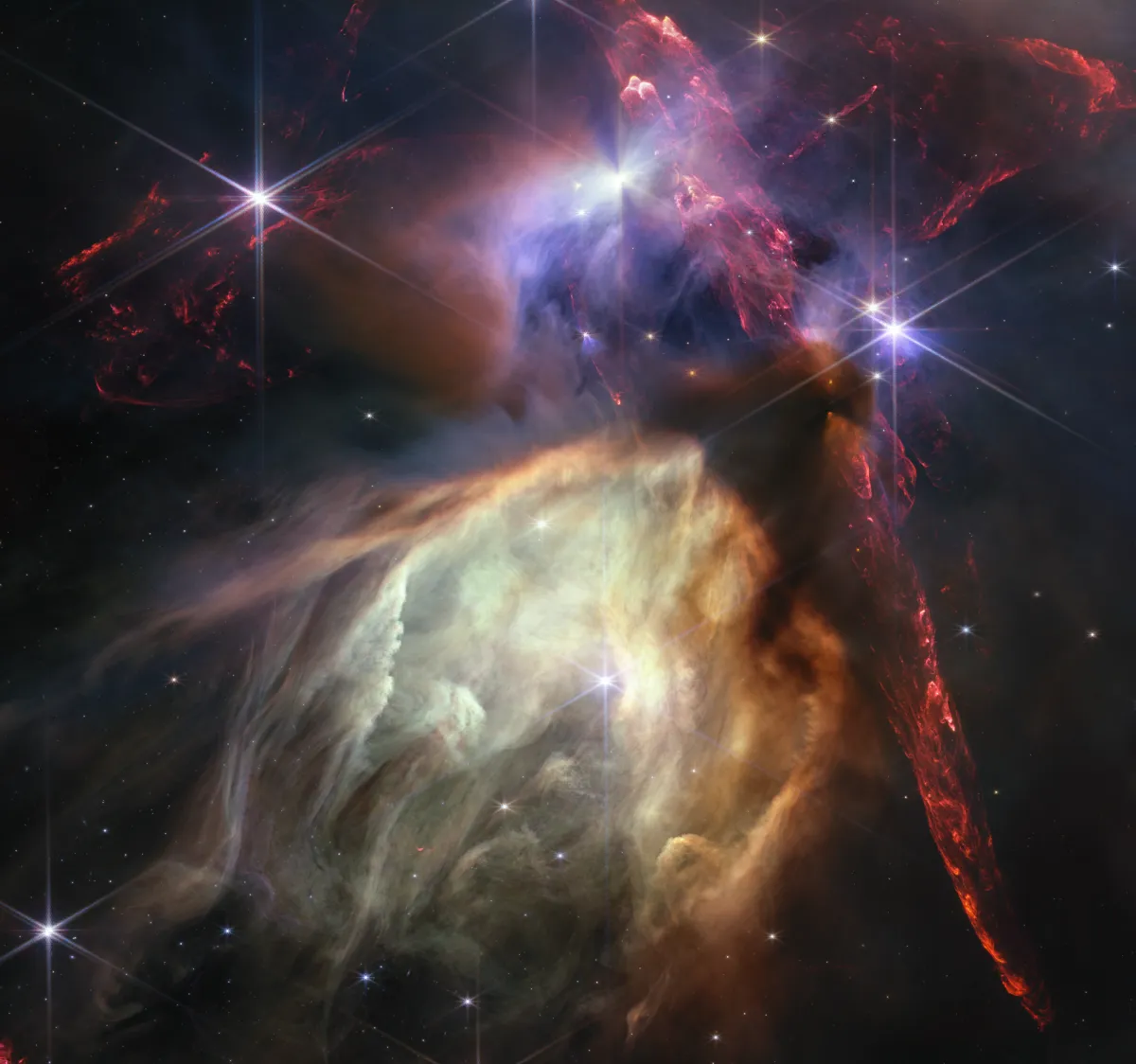
Webb celebrated its first year of science operations with this view of the Rho Ophiuchi cloud complex.
The Rho Ophiuchi complex is the closest star-forming region to Earth, at 'just' 390 lightyears away.
Get the full story on Webb's Rho Ophiuchi image
Saturn

On 25 June 2023, Webb captured this amazing image of Saturn, showing its moons Dione, Enceladus and Tethys, along with its rings.
For the full story, read our guide to the Webb image of Saturn.
Cassiopeia A
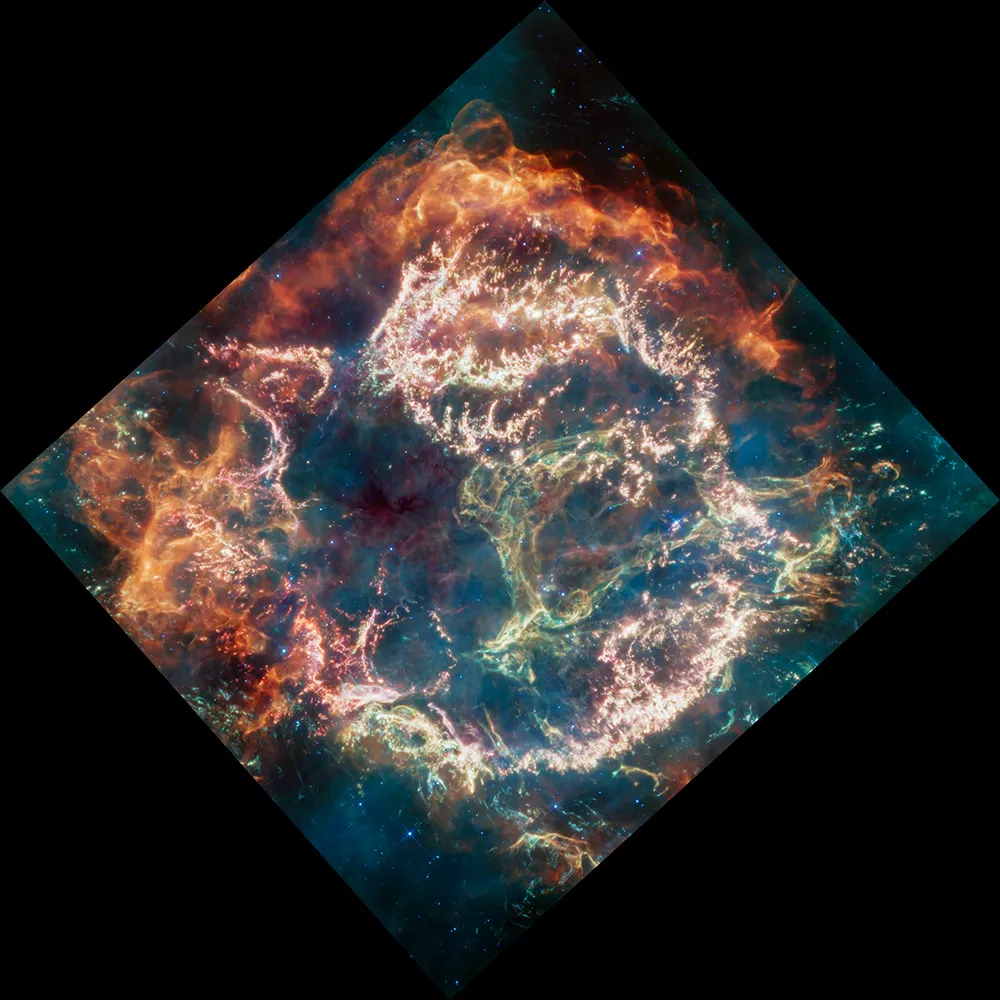
This is Cassiopeia A, a supernova remnant located 11,000 lightyears away that spans 10 lightyears across.
The Webb image contains all the chaos and beauty you would expect from the remnants of an exploded star, including cosmic material glowing orange and red due to emission from warm dust.
In these areas, material ejected by the exploded star has smashed into the surrounding material.
The knotted filaments that appear pink in the image are material from the star itself, shining due to the presence of heavy elements and dust emission.
Uranus (2023)
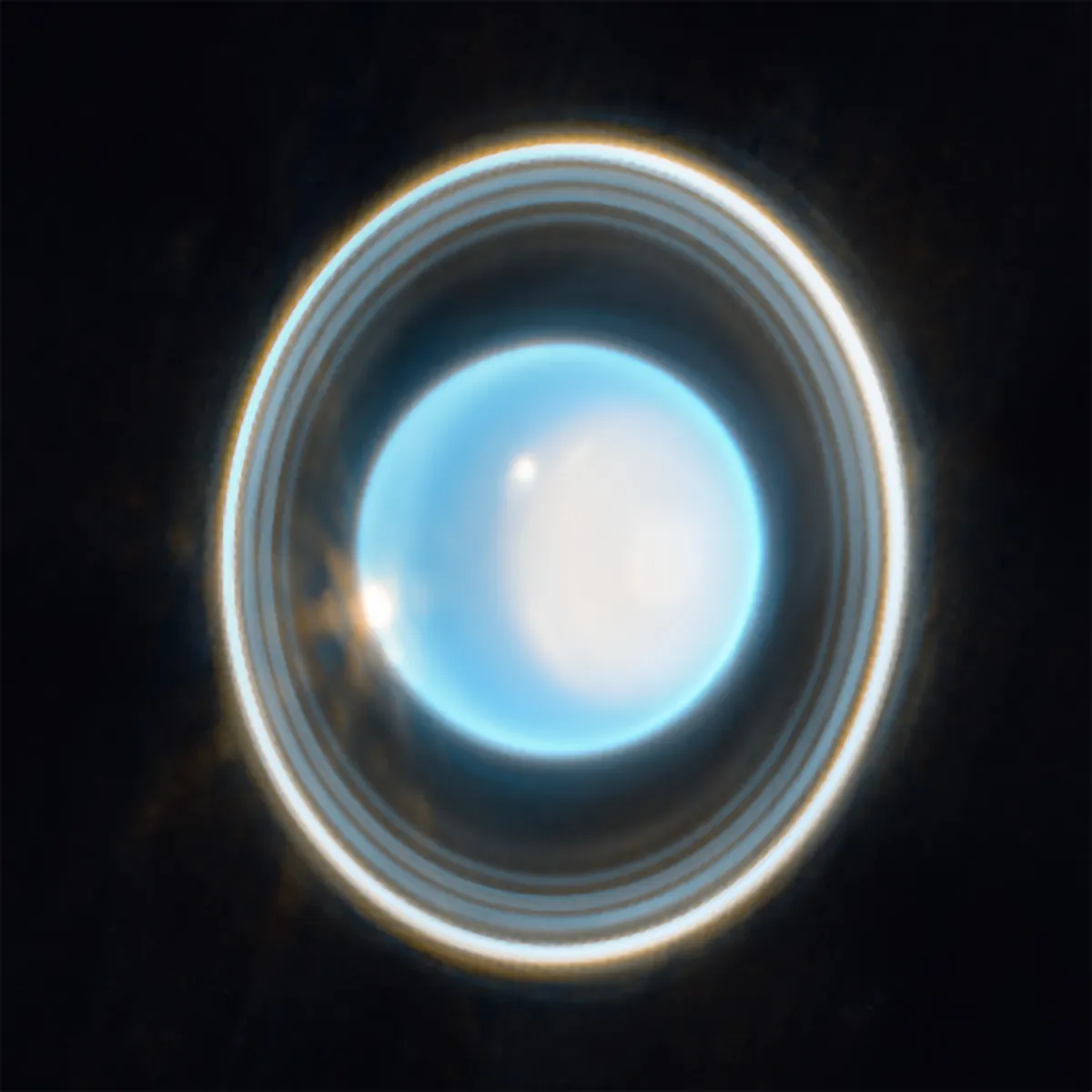
This image of Uranus was captured by the James Webb Space Telescope on 6 February 2023 and shows an amazing view of the planet's ring.
The bright region on the right side of the planet is Uranus's polar cap, which is unique to Uranus because it is the only planet in the Solar System that's tilted on its side, causing extreme seasonal changes.
Pandora's Cluster
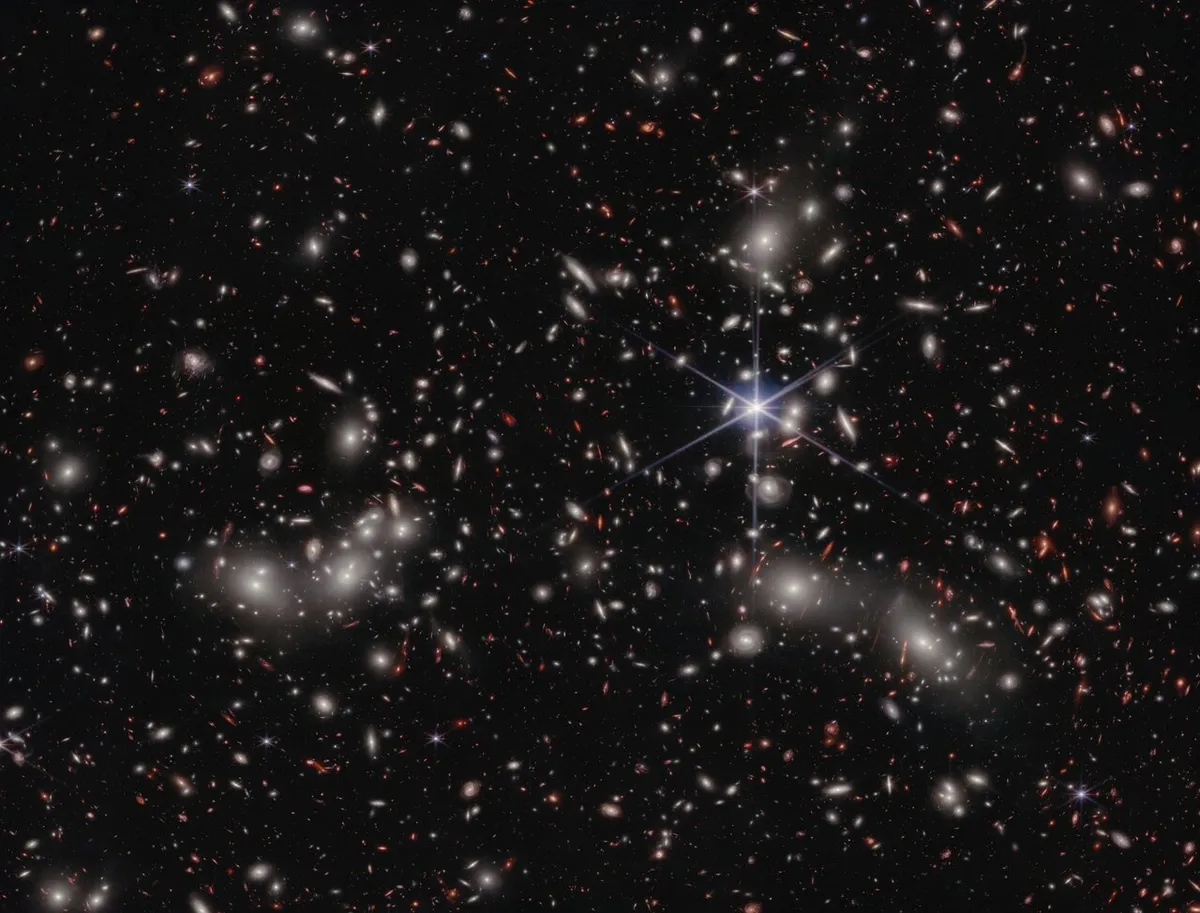
The latest deep-field image captured by the James Webb Space Telescope shows a region in deep space known as Pandora's Cluster, or Abell 2744.
It reveals the intricate structures of three galaxy clusters - together forming a so-called 'megacluster' - in detail never seen before by astronomers.
The image of Pandora's Cluster is a panoramic composed of four individual JWST images sewn together.
One noteworthy feature of the image is that it displays gravitational lensing, where the mass of the galaxy clusters is warping and distorting the light from more distant galaxies.
In this way, the galaxy megacluster is acting like a cosmic magnifying glass, enabling astronomers to see the distant galaxies more clearly.
Find out more in our story about the Webb Telescope's image of Pandora's Cluster.
Webb Telescope's image of distant galaxies
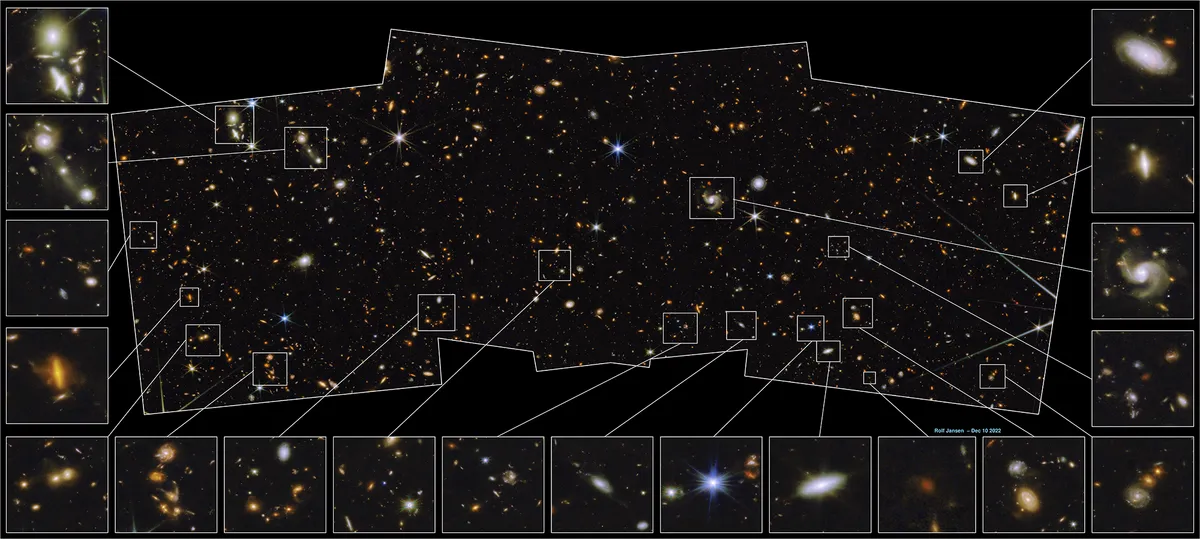
This image captured by the James Webb Space Telescope shows 1000s of distant galaxies and covers an area of the sky just 2% of the area covered by the full Moon.
The faintest objects in the image are about 1 billion times fainter than what can be seen with the naked eye.
This is referred to as a 'medium-deep wide-field' image.
Light from the most distant galaxies has traveled almost 13.5 billion years to reach us.
Read more about Webb's PEARLS galaxies image

Credit: Science: NASA, ESA, CSA, Rolf A. Jansen (ASU), Jake Summers (ASU), Rosalia O'Brien (ASU), Rogier Windhorst (ASU), Aaron Robotham (UWA), Anton M. Koekemoer (STScI), Christopher Willmer (University of Arizona), JWST PEARLS Team
Image Processing: Rolf A. Jansen (ASU), Alyssa Pagan (STScI)
Webb's cosmic hourglass image
JWST's latest image is of a protostar embedded within an hourglass-shaped cosmic cloud
The star is just 100,000 years old and thought to be in the earliest stages of star formation.
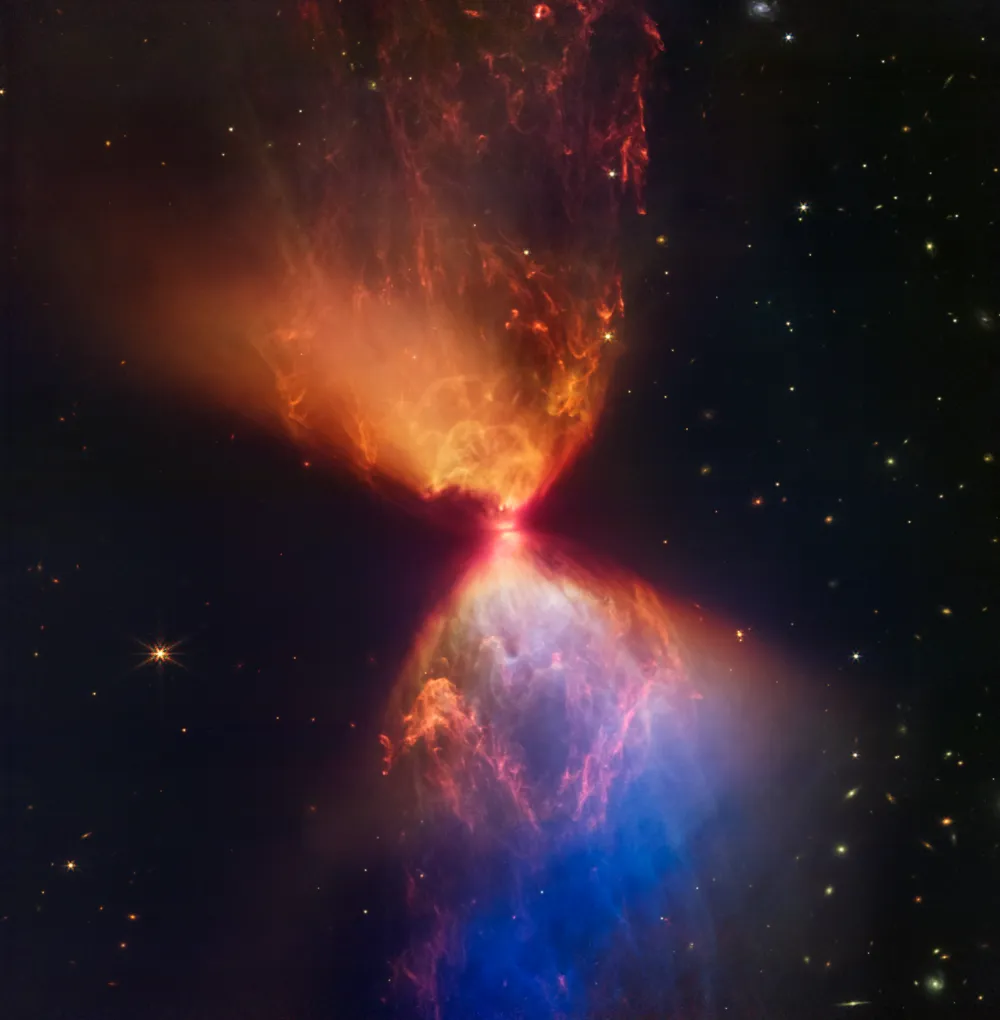
Once hidden from sight within dark cloud L1527, the features of this protostar are revealed Webb’s Near-Infrared Camera (NIRCam).
The protostar is still a long way from becoming a fully-fledged star, and as a result it is not yet undergoing nuclear fusion of hydrogen.
This disk seen as a grey streak at the centre of the image is about the size of our own Solar System.
Perhaps Webb has offered us a glimpse of what our own Sun must have looked like in its infancy.
Find out more about Webb's image of L1527
Webb's Pillars of Creation
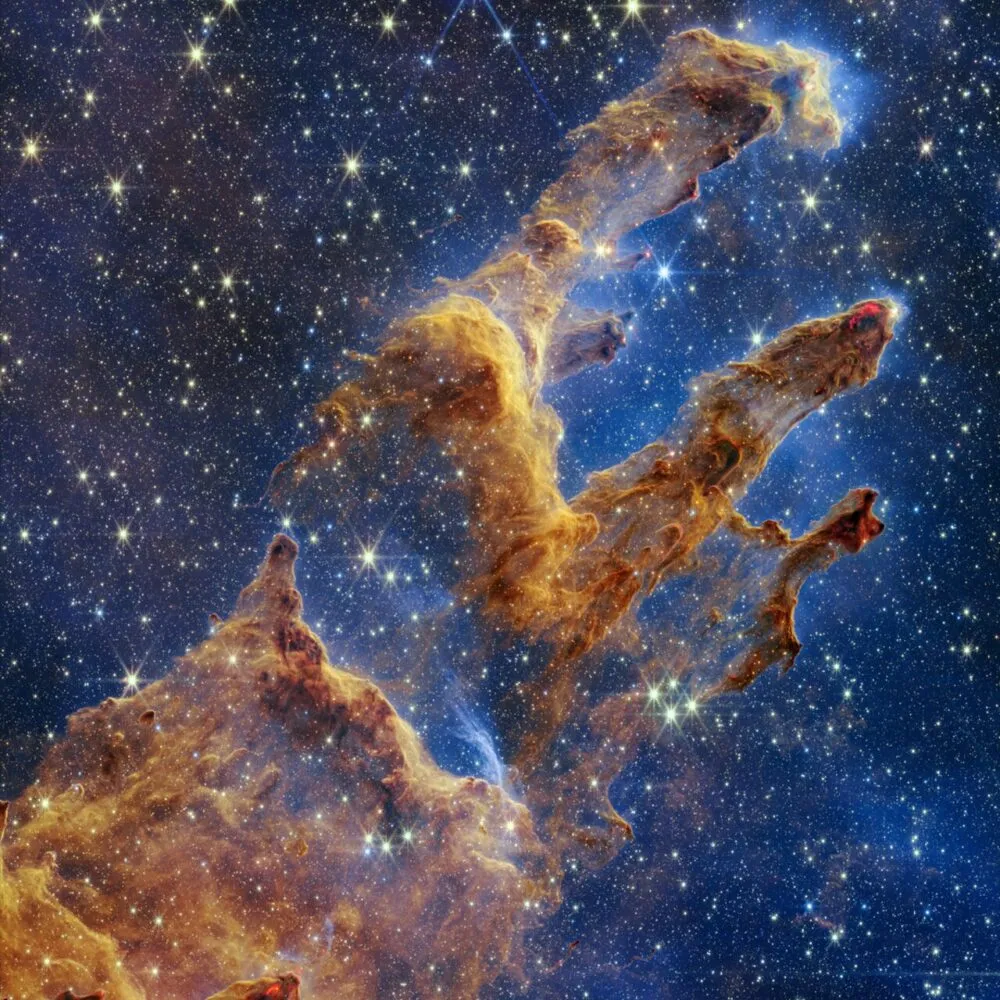
October 2022, NASA released this incredible JWST image of the Pillars of Creation, a star-forming region in the Eagle Nebula that contains dense pillars of cosmic dust and gas.
The image calls to mind the Hubble Space Telescope image of the Pillars of Creation - perhaps Hubble's most famous image - and is further evidence of just what the Webb Telescope can achieve.
Find out more about this incredible image in our guide to the Webb Telescope's image of the Pillars of Creation.
Webb's image of Wolf-Rayet 140
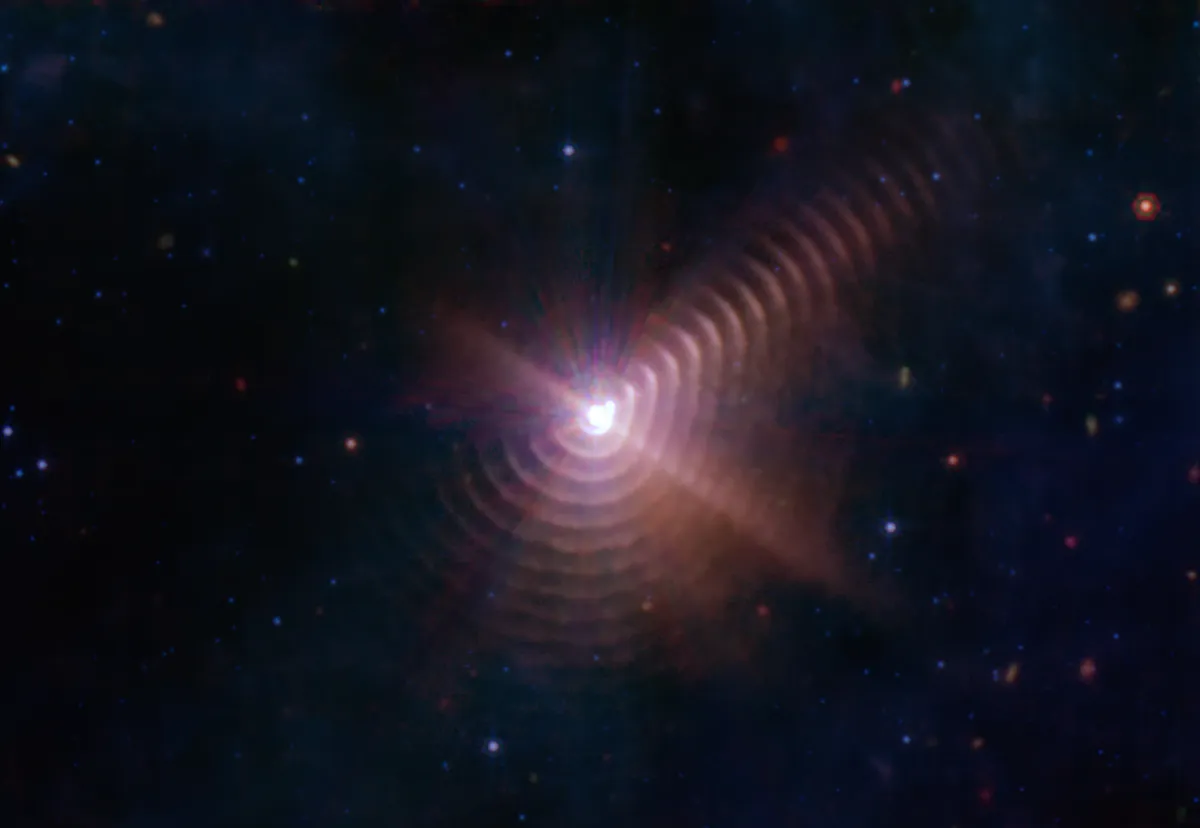
In mid-October the James Webb team released an image captured by the telescope showing a binary star called Wolf-Rayet 140
Also seen in the image are shells of cosmic dust being ejected from the binary system out into space.
At least 17 rings can be seen in the image. These are shells of dust formed as the orbiting binary stars pass close by one another.
Each close orbital pass causes their stellar winds - streams of particles emanating from the stars - to interact, ejecting the shells out into space.
Read more in our news story about the Webb Telescope's image of binary star Wolf-Rayet 140
Webb's image of Neptune and its rings
Planet fans have been treated to a wonderful James Webb Space Telescope image of Neptune, captured on 12 July 2022, showing the ice giant rings and faint dust bands in amazing detail.
It calls to mind the incredible images of Neptune sent back by the Voyager 2 spacecraft when it flew by the planet in 1989.
Yet where is that vibrant blue hue that we saw in the Voyager images?
The answer lies in Webb’s Near-Infrared Camera (NIRCam), which photographs its targets in near-infrared.
And the methane gas that makes Neptune appear blue in the Voyager 2 images actually absorbs red and infrared light, so the planet appears almost dark in the JWST images.
The large, bright point of light with diffraction spikes that seen in the image is Triton, Neptune's largest moon. Also visible are 7 more of Neptune's 14 known moons.
NASA says more Webb studies of Triton and Neptune are expected in 2023.
Webb's image of the DART asteroid collision

Both the James Webb Space Telescope and the Hubble Space Telescope were able to photograph the moment NASA's DART mission purposely impacted into its asteroid target.
The images were released by NASA and ESA in the days following the successful crash, providing a fascinating perspective of the aftermath of the first successful asteroid deflection test in human history.
See Webb and Hubble's DART mission images.
Webb Telescope's image of the Tarantula Nebula
In September 2022 the James Webb Space Telescope team released this mesmerising view of the Tarantula Nebula.
The Tarantula is a star-forming region located 161,000 lightyears away in the Large Magellanic Cloud, a satellite galaxy of our own Milky Way galaxy and part of our Local Group.

Webb’s infrared vision reveals thousands of stars in this region, which is also known as 30 Doradus, never seen before by astronomers. The image also shows distant background galaxies.
The image of the Tarantula Nebula was captured with the Near-Infrared Camera (NIRCam), which provides a view of the central cavity in the nebula, hollowed out by radiation from massive young stars.

The Tarantula Nebula appears completely different in the second image, above, captured by the Mid-infrared Instrument (MIRI).
In the longer infrared wavelengths, stars no longer appear so bright, and the cooler surrounding cosmic dust and gas glows.
Points of light seen within the clouds are protostars embedded in the nebula.
Webb's view of the Phantom Galaxy, M74
In August 2022, the James Webb Space Telescope team released this view of the Phantom Galaxy, also known as M74,
This face-on spiral galaxy is 32 million lightyears away, and the Webb Telescope captured a view of its spiral arms and filaments of cosmic gas and dust
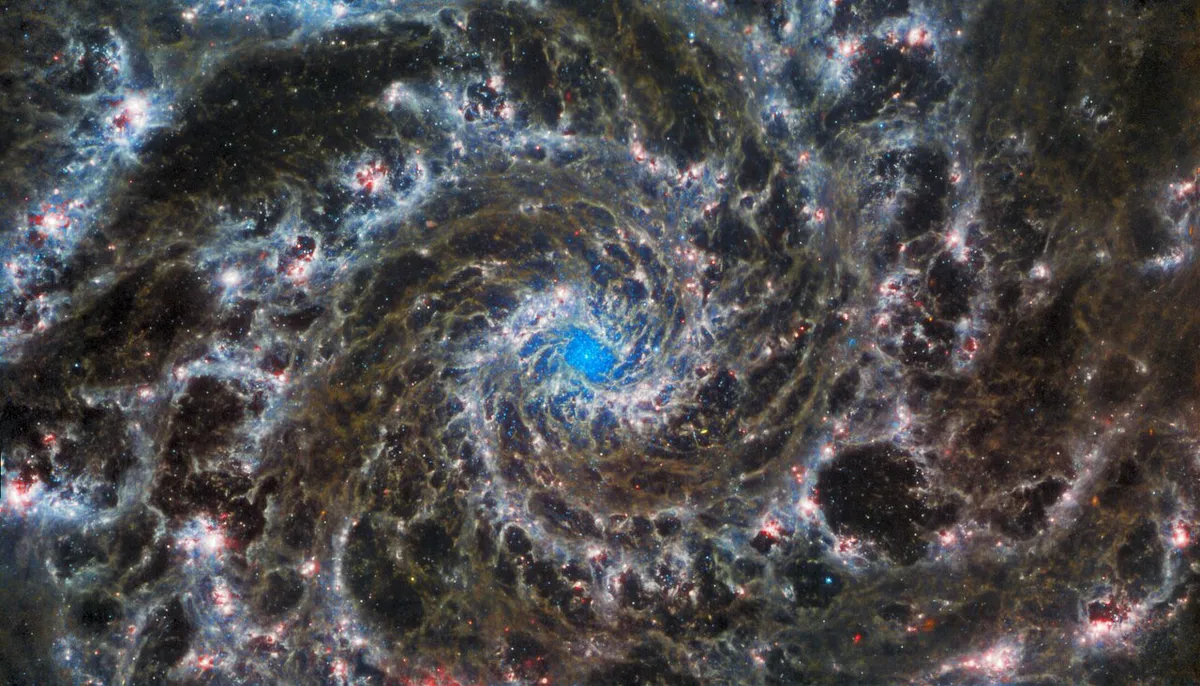
Webb captured this image of the Phantom Galaxy with its Mid-InraRed Instrument (MIRI), which views in infrared and enables astronomers to observe deeper than before, studying features that would be obscured when observing in optical light.
The data was processed by citizen scientist Judy Schmidt.
Views like this help astrophysicists learn more about the structure and evolution of galaxies and reveal the processes behind star formation.
Webb's view of the Cartwheel Galaxy
This JWST image is a view of the Cartwheel Galaxy, a composite produced by the telescope’s Near-Infrared Camera (NIRCam) and Mid-Infrared Instrument (MIRI).
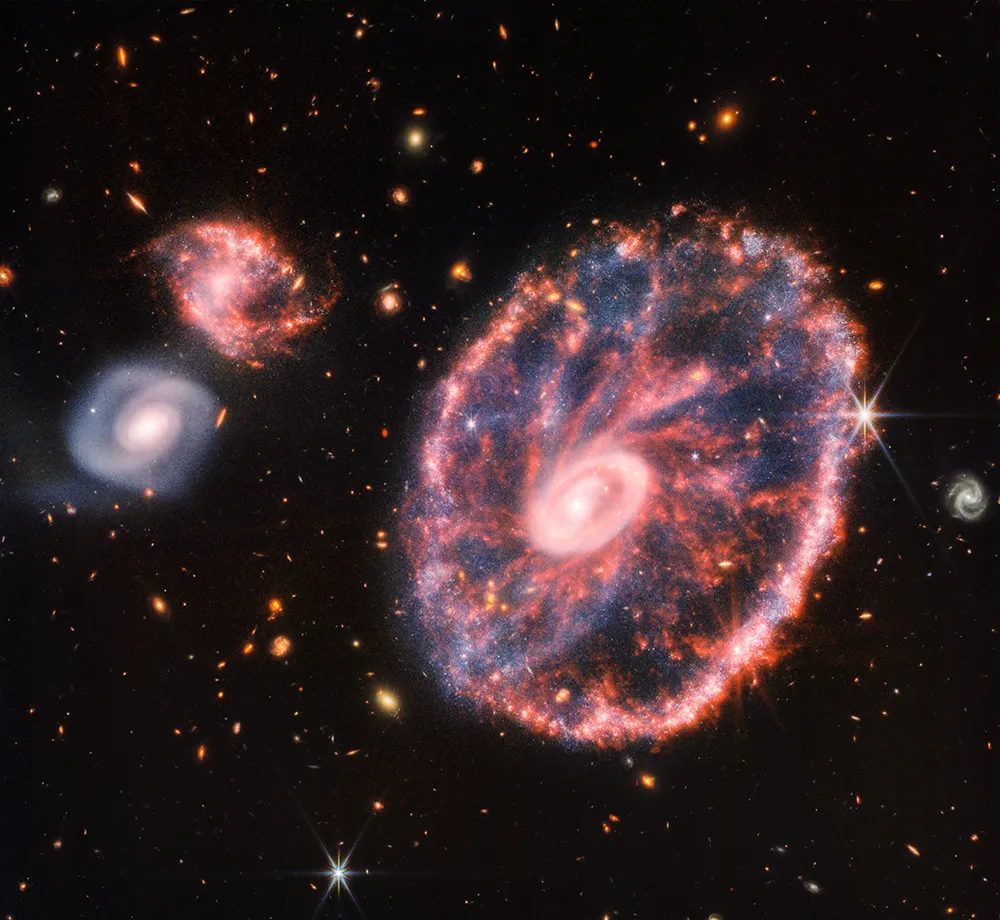
The Cartwheel Galaxy is the result of a collision between two different galaxies that took place about 400 million years ago.
What remains is an inner ring and an outer ring, giving the galaxy merger the appearance of a spoked wheel.
These 'spokes' are actually the remnants of the arms of the larger galaxy, which have been distorted as a result of a collision with a smaller galaxy.
The scene appears red through Webb's infrared view as a result of the glow from hydrocarbon-rich cosmic dust.
Galaxy mergers are some of the most spectacular events in the cosmos and make for incredible images, as this JWST image shows.
One day our own Milky Way galaxy will collide with the neighbouring Andromeda Galaxy, resulting in an event referred to as the Andromeda-Milky Way collision.
Images like this one captured by the Webb Telescope perhaps give us an insight into the fate of our own galaxy's future.
Webb Telescope's Jupiter images
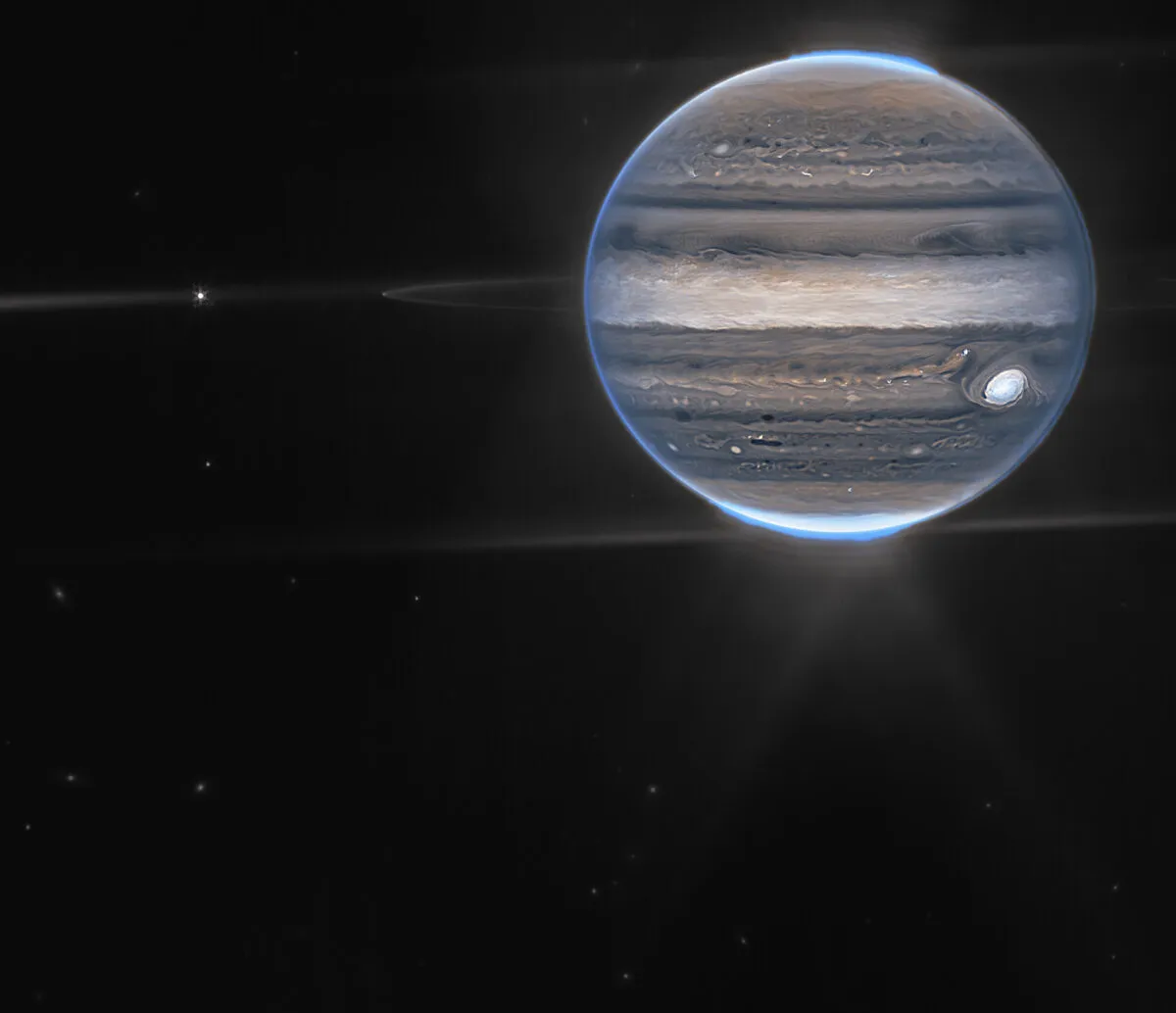
An image captured by the James Webb Space Telescope shows Jupiter and two of its tiny moons, Amalthea and Adrastea.
The data was captured using the Webb Telescope's NIRCam instrument, which observes in infrared, and the image was processed in collaboration with citizen scientist Judy Schmidt.
Visible in the image are Jupiter's aurora above its north and south poles, its faint rings and the huge storm known as the Great Red Spot.
JWST has given planetary scientists a new view of the tempestuous gas giant.
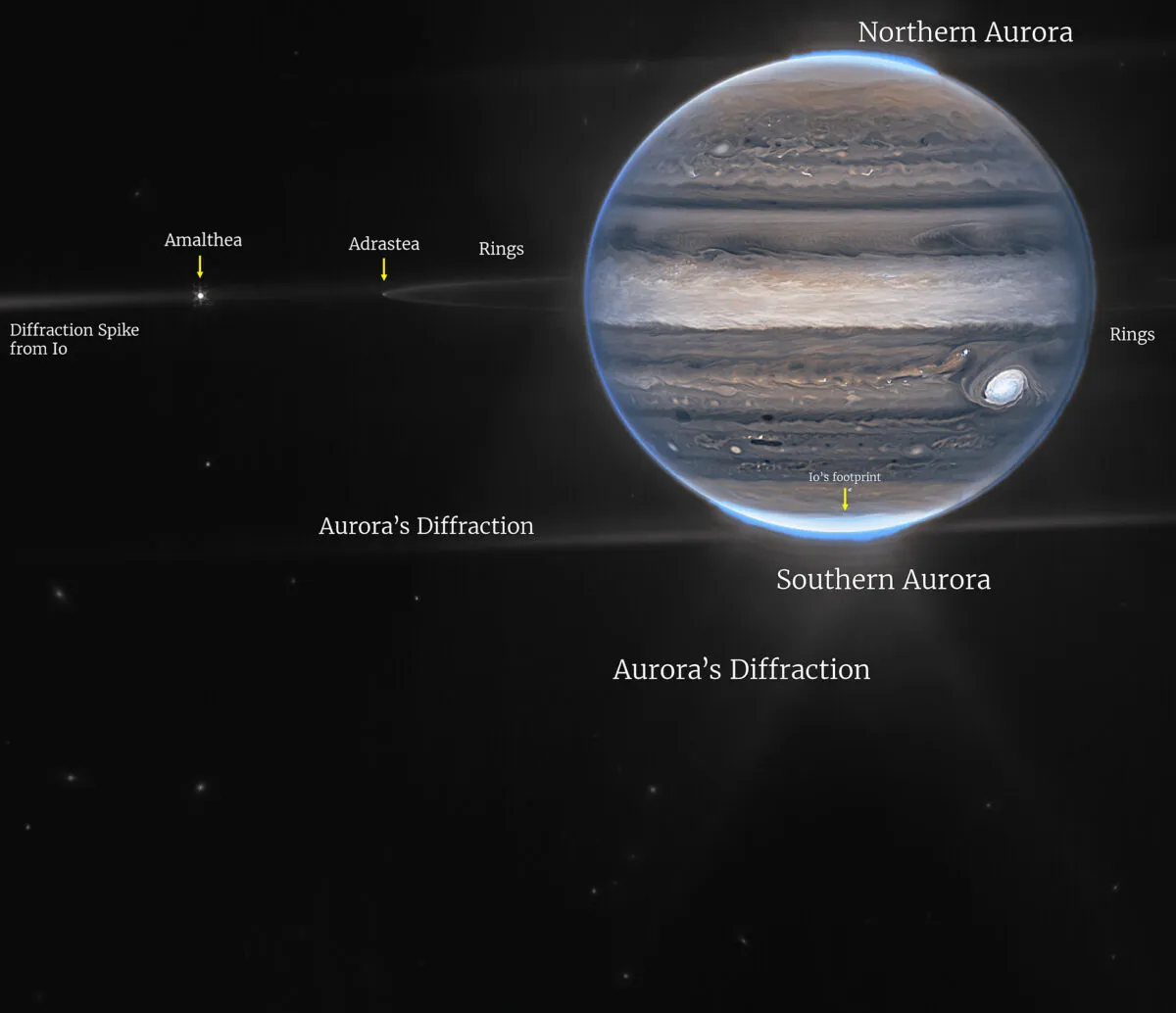
“We hadn’t really expected it to be this good, to be honest,” says planetary astronomer Imke de Pater of the University of California, Berkeley, who led this study of Jupiter with Thierry Fouchet, a professor at the Paris Observatory.
“It’s really remarkable that we can see details on Jupiter together with its rings, tiny satellites, and even galaxies in one image."
Jupiter and moon Europa
These images from JWST show Jupiter and its moon Europa, captured by the telescope’s NIRCam instrument.
Not long after the first JWST images were released on 12 July came these incredible images of the tempestuous gas giant planet and its intriguing moon.
NIRCam’s short-wavelength filter reveals Jupiter’s distinctive bands and famous Great Red Spot; a gigantic storm that’s wider than planet Earth.

"Combined with the deep field images released the other day, these images of Jupiter demonstrate the full grasp of what Webb can observe, from the faintest, most distant observable galaxies to planets in our own cosmic backyard that you can see with the naked eye from your actual backyard," says Bryan Holler, a scientist at the Space Telescope Science Institute in Baltimore, who helped plan these observations.
To the left of the planet we can clearly see a black spot. This is Europa, one of Jupiter’s Galilean Moons and a key target in the search for habitable conditions in our Solar System.
See that black spot just to the left of the Great Red Spot (the white blob on Jupiter)? That’s Europa’s shadow, cast onto Jupiter’s cloud tops.
Europa has a subsurface ocean beneath its icy crust, meaning it has the potential to support life, and is due to be studied in-depth by the upcoming Europa Clipper mission.
The Cassini mission at Saturn, for example, was able to see plumes of material erupting from the subsurface ocean of moon Enceladus, and JWST scientists are hoping that the space telescope may be able to spot similar phenomena on Europa in future observations.
Perhaps even more fascinating is a clear capture of Jupiter’s rings, which can be seen in another of the NIRCam images.
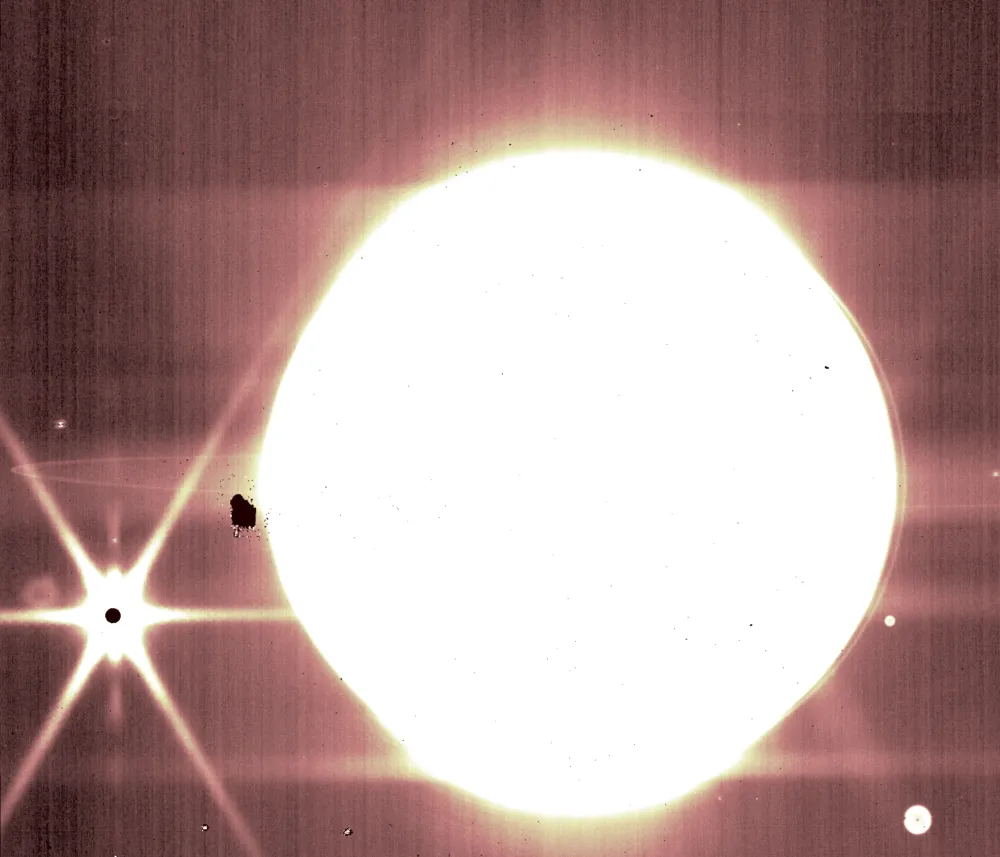
Yes, Jupiter has rings, and the Webb Telescope has managed to show these distinct features with remarkable clarity.
We can also see moons Thebe and Metis in the new Jupiter images.
"The Jupiter images in the narrow-band filters were designed to provide nice images of the entire disk of the planet," says John Stansberry, NIRCam commissioning lead at the Space Telescope Science Institute.
"But the wealth of additional information about very faint objects (Metis, Thebe, the main ring, hazes) in those images with approximately one-minute exposures was absolutely a very pleasant surprise."
James Webb Space Telescope's first images
These were the first images from the Webb Telescope ever to be released to the public.
SMACS 0723
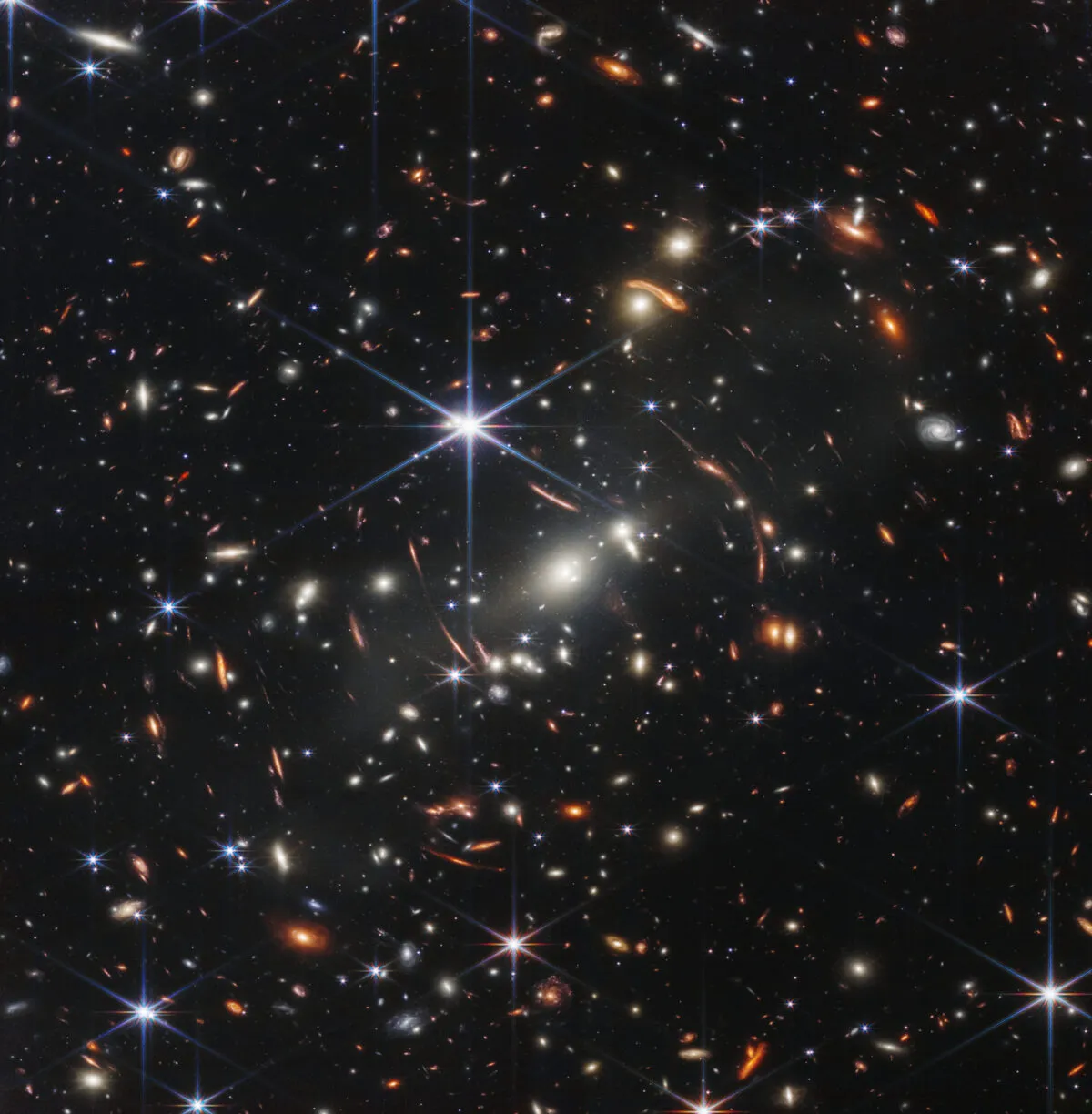
The first image to be released by the James Webb Space Telescope is the deepest infrared image of the distant Universe ever produced.
Following in the footsteps of the Hubble Deep Field, the image has become known as Webb's First Deep Field.
It shows galaxy cluster SMACS 0723, and in the background, thousands of galaxies, including some of the faintest objects ever observed in the Universe.
The deep field was captured by one of the Webb Telescope's instruments known as the Near-Infrared Camera (NIRCam), and was produced using 12.5 hours' worth of images captured at different wavelengths.
Because Webb peered so far into space to capture the image, it was able to observe distant light that's been travelling across the cosmos. for billions of years.
As a result, galaxy cluster SMACS 0723 appears here as it would have existed 4.6 billion years ago.
This is one of the key aspects of Webb's science goals over the coming years: astronomers are keen to observe further into deep space, and in doing so learn more about the early Universe.
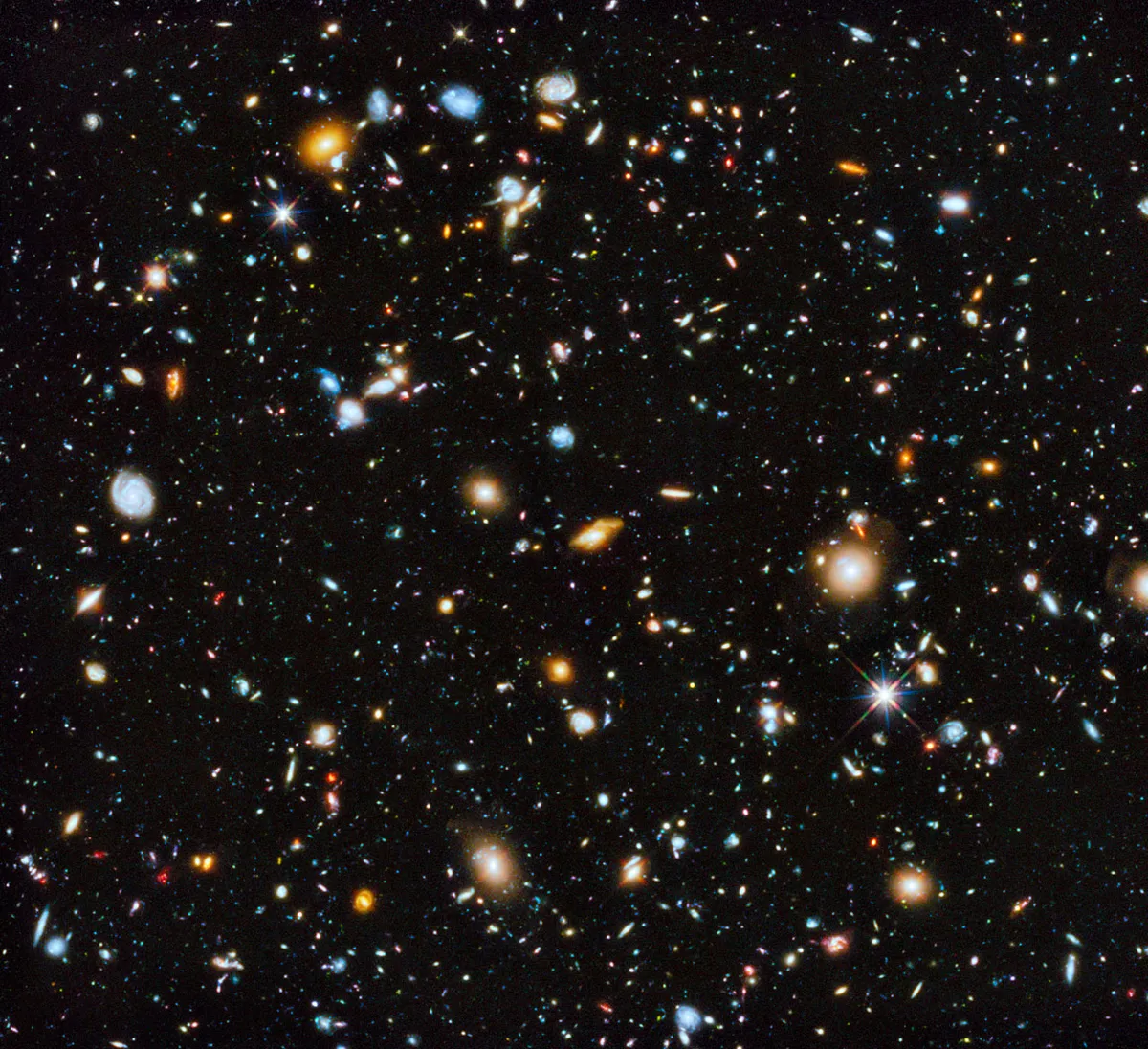
Another interesting aspect of the image is that it shows a phenomenon known as gravitational lensing in action.
The combined mass of galaxy cluster SMAGS 0723 is warping and magnifying the light from more distant galaxies behind it.
This presents astronomers with a sort of cosmic magnifying glass, enabling them to observe distant objects in greater detail.
It's also why some of the light from those distant galaxies seems curved and warped.
Now astronomers will begin to analyse and learn more about these distant galaxies and the tiny structures seen within.
Exoplanet WASP-96 b (spectrum)
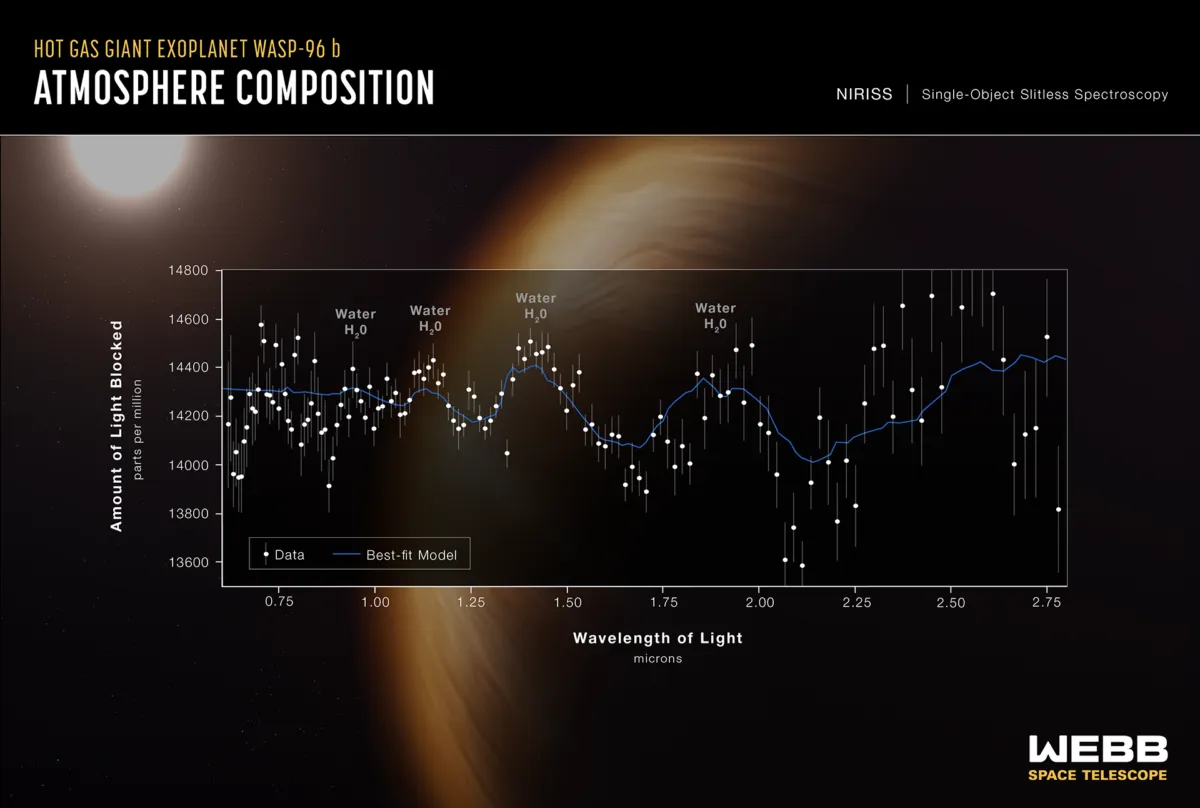
WASP-96 b is a giant planet outside our Solar System, known as an exoplanet. The planet is composed mainly of gas and is located just 1,150 lightyears away. It's about half the mass of Jupiter and it orbits its star every 3.4 Earth days.
This is a transmission spectrum made by observing exoplanet WASP-96b.
The spectrum was created by analysing light that passed through the exoplanet's atmosphere as it orbited in front of its host star.
Each of the 141 points on the graph shows the amount of a specific wavelength of light that's blocked by the exoplanet and absorbed by its atmosphere.
Note the labelled peaks in the graph, indicating the presence of water vapour in WASP-96b's atmosphere.
The heights of the peaks - along with other aspects of the spectrum - enabled astronomers to infer the temperature of the exoplanet to be about 1350°C.
This is the most detailed infrared exoplanet transmission spectrum ever produced, and an indication of just how much the Webb Telescope could revolutionise the field of exoplanet study.
Southern Ring Nebula

The Southern Ring Nebula is an object known as a planetary nebula, which is an expanding cloud of gas around a dying star. Their puffed-out, spherical appearance is what has given them the name 'planetary nebulae'.
Astronomers say that the dimmer star at the centre of the image has been emitting loops of cosmic gas and dust into space in all directions.
Two JWST cameras were used to capture this image of the planetary nebula, which is located about 2,500 lightyears away.
The Southern Ring Nebula is visible to observers living in the southern hemisphere, as it can be found within the southern constellation of Vela.
Stephan’s Quintet
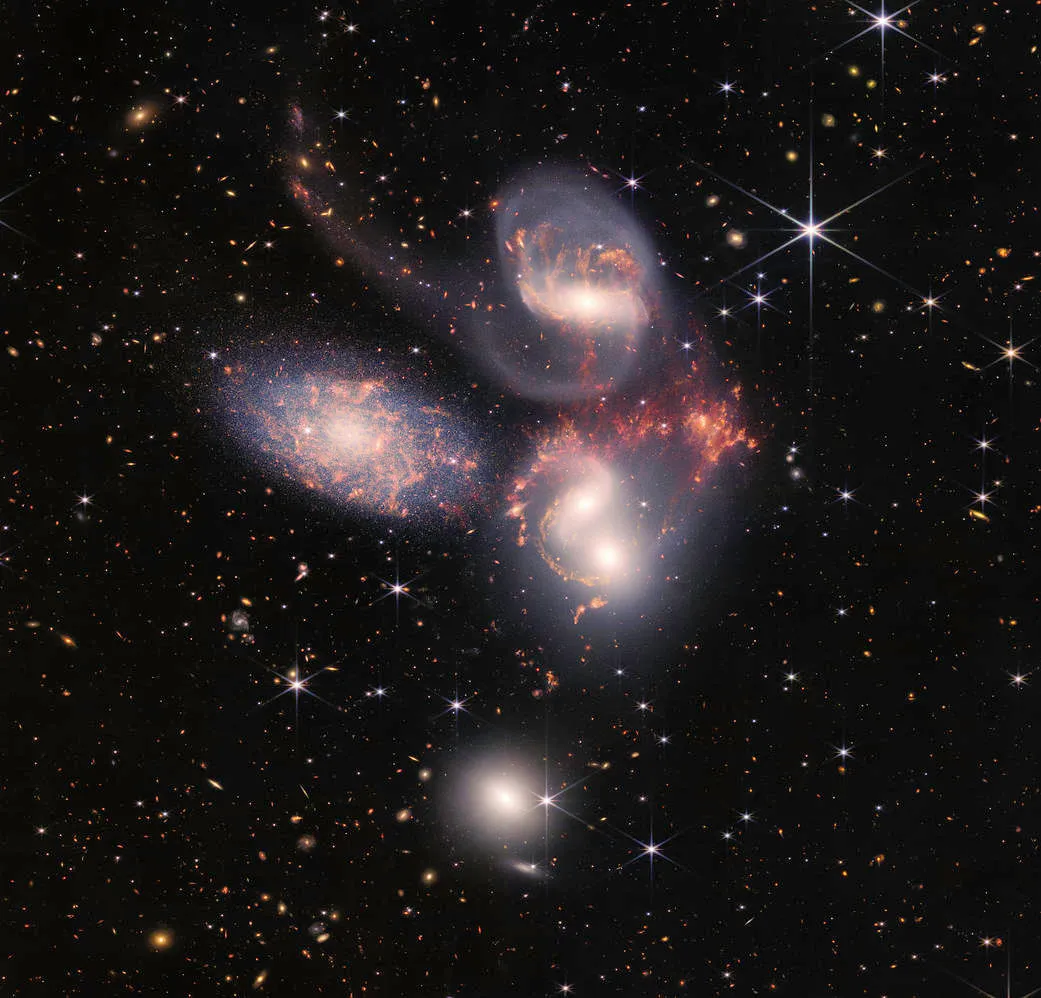
This is a group of galaxies known as Stephan's Quintet, a compact galaxy group located 290 million lightyears away in the constellation Pegasus, in the same patch of sky as the famous asterism known as the Great Square of Pegasus.
This brand new image of Stephan's Quintet contains over 150 million pixels and was produced using nearly 1,000 separate image files captured by the James Webb Space Telescope.
It was captured using the telescope's Near-Infrared Spectrograph (NIRSpec) and Mid-Infrared Instrument (MIRI)
Webb's incredible image shows clusters of young stars and bursts of star birth across the galaxy group.
While it may seem like the 5 separate galaxies in the group are gravitationally bound, actually only 4 of them are. The 5th and leftmost galaxy is NGC 7320, and it's actually much closer to Earth than the other 4 galaxies.
NGC 7320 is 40 million lightyears from Earth while the others are about 290 million lightyears away.
One of the major takeaways from this image is that Webb can provide an incredible view of galaxies gravitationally interacting and merging: a key aspect of understanding how galaxies evolve and change over time.
Stephan's Quintet in a different light
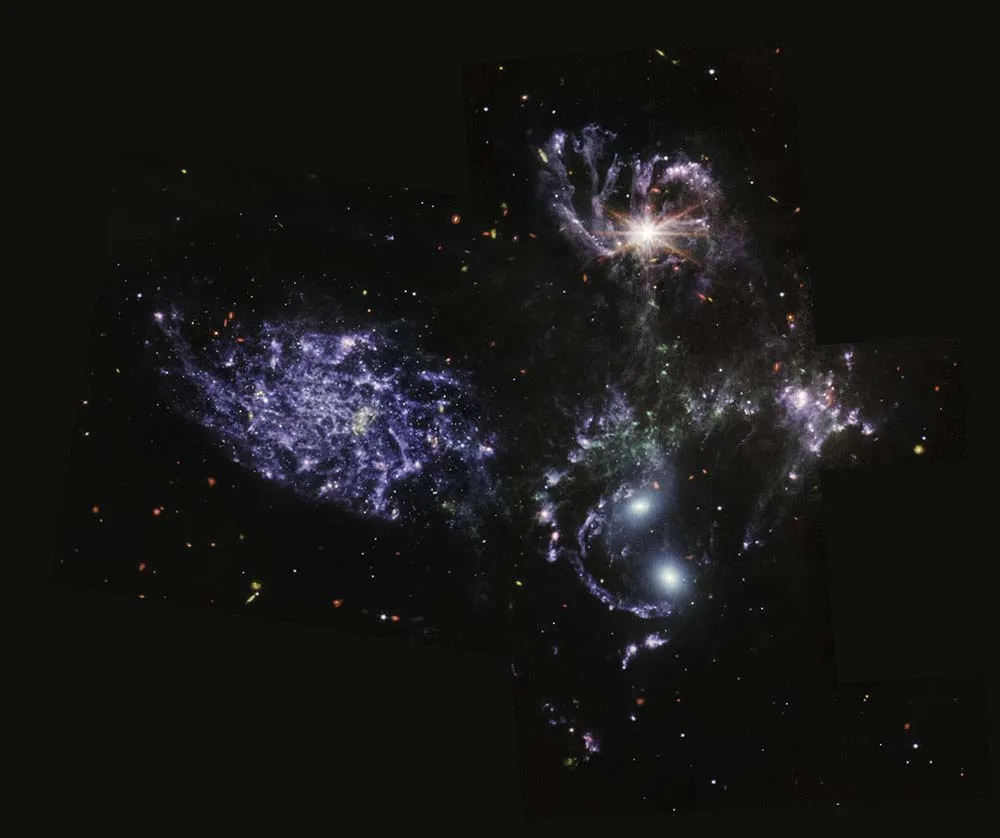
Here's another Webb image of Stephan's Quintet captured using just the MIRI instrument.
The image was produced using one more MIRI filter than the NIRCam/MIRI composite image, enabling JWST to observe through more cosmic dust to reveal the secrets of galaxy mergers and galactic evolution.
Image processing scientists working on the data at the Space Telescope Science Institute used all three MIRI filters and colours red, green and blue to more clearly see distinct features of each galaxy and the shockwaves generated between the galaxies as they merge.
Red indicates star-forming regions, distant early galaxies and galaxies covered in dense cosmic dust.
Blue shows stars or star clusters without dust, while more diffuse areas of blue reveal dust containing large amount of hydrocarbon molecules.
Green and yellow represent more distant, earlier galaxies that are also rich in hydro carbons.
The Carina Nebula

The Carina Nebula is a glowing cosmic cloud found about 7,600 lightyears away in the southern hemisphere constellation Carina.
It's a common and well-known target for astronomers and astrophotographers, but none of them will ever have seen it like this!
This image of the Carina Nebula, NGC 3324, was captured in infrared light by the JWST and shows 'peaks' of glowing cosmic gas and dust about 7 lightyears high.
Ultraviolet radiation and streams of charged particles known as stellar winds are emanating from hot young stars within the nebula, sculpting and shaping the cavernous formations seen in this image.
JWST's infrared vision is able to peer through the cosmic dust to see stellar nurseries and individual newborn stars that would normally be obscured in optical light.
Images like these show just how much astronomers can learn from the Webb Telescope about how stars are born, how they affect and influence their own cosmic neighbourhood.
This image was captured by Webb’s Near-Infrared Camera (NIRCam) and Mid-Infrared Instrument (MIRI).
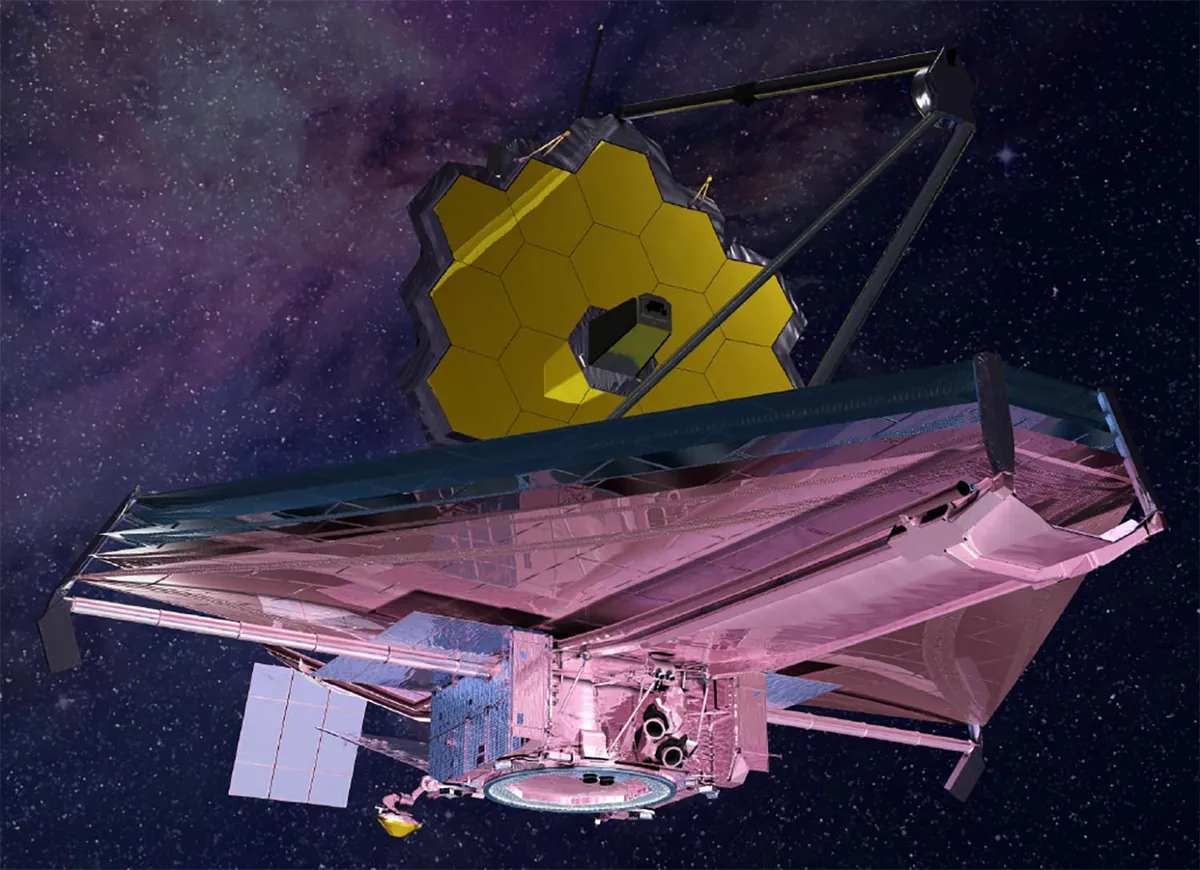
"What I have seen moved me, as a scientist, as an engineer, and as a human being," says NASA deputy administrator Pam Melroy
NASA says it took 5 years to decide which targets the James Webb Space Telescope should observe and image first, and that the decision was a collaboration between NASA, ESA, CSA and the Space Telescope Science Institute.
Seeing JWST's first images
The first images released by the James Webb Space Telescope were full-colour images to showcase what the telescope can do, and since then we've seen a wealth of amazing images captured by the telescope.
Find out more about James Webb Space Telescope's initial alignment images below.
James Webb's thermal stability test image
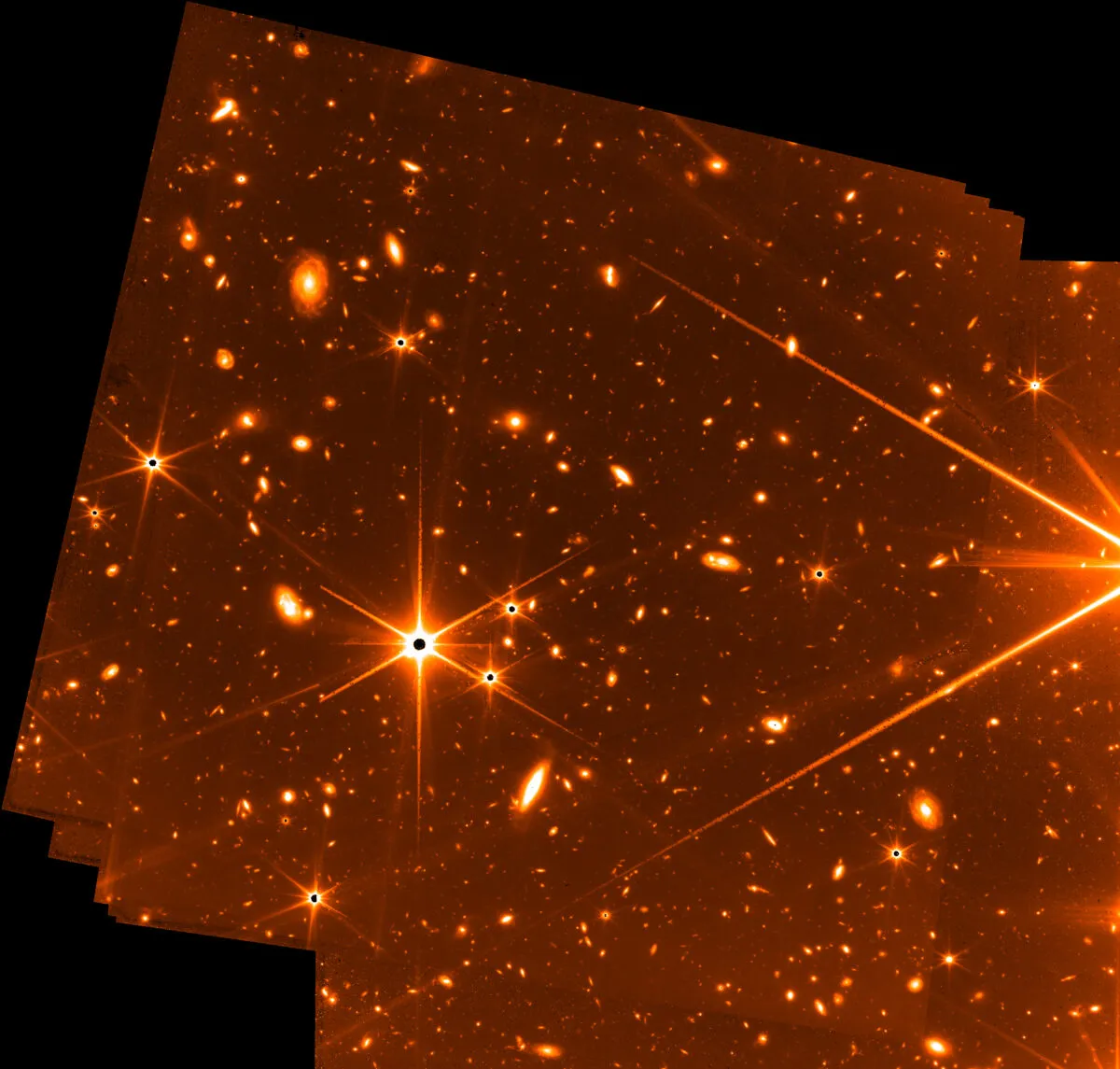
One of the most recent James Webb Space Telescope test images released by NASA shows a view of stars and galaxies captured by JWST's Fine Guidance Sensor in mid-May 2022.
The image was captured as part of a thermal stability test to see how well the Webb telescope can stay locked onto a target.
While this is not a full colour image like those currently being released by the JWST team, it does reveal a few interesting elements, such as Webb's distinctive diffraction spikes on the stars, which are a result of the telescope's 6-sided mirror segments.
Looking beyond the stars, the bright blobs visible across the image are galaxies stretching far into deep-space.
This image was captured using 72 exposures over 32 hours and, say NASA scientists, is one of the deepest images of the Universe ever taken.
JWST's image of the Large Magellanic Cloud
In May 2022, NASA released an image by the James Webb Space Telescope that shows an amazing view of the Large Magellanic Cloud, a satellite galaxy of the Milky Way.
The image was captured with JWST's coldest instrument: the Mid-Infrared Instrument, or MIRI.
Focussing on the star field of the Large Magellanic Cloud provided an opportunity for Webb scientists to test the telescope's imaging performance.
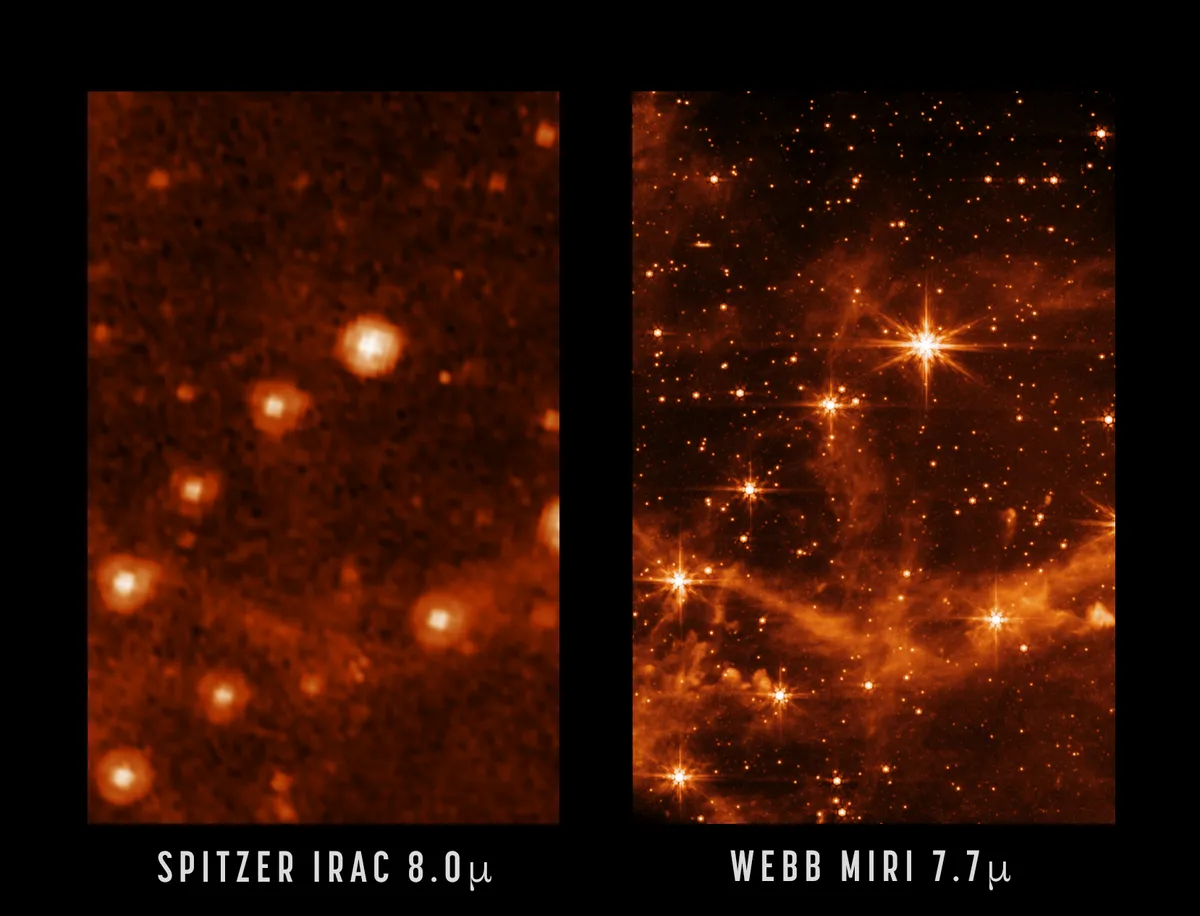
NASA released a side-by-side pair of images (above) showing how James Webb Space Telescope's capabilities compare to the Spitzer Space Telescope.
The now-retired Spitzer observatory captured hi-res images of the Universe in near- and mid-infrared.
"Webb, with its significantly larger primary mirror and improved detectors, will allow us to see the infrared sky with improved clarity, enabling even more discoveries," a NASA statement said.
Webb's image of 2MASS J17554042+6551277
After weeks of alignment, NASA finished focusing the James Webb Space Telescope's primary mirror on 11 March 2022, achieving a precision that exceeded the original goal and resulted in the image below: an image of star 2MASS J17554042+6551277, released on 16 March 2022.
The image was significant because it showed that each of JWST's 18 primary mirror segments - which produce the space telescope's iconic 'honeycomb' mirror design - had been aligned correctly.
JWST had taken one more step towards beginning its exploration of the cosmos.
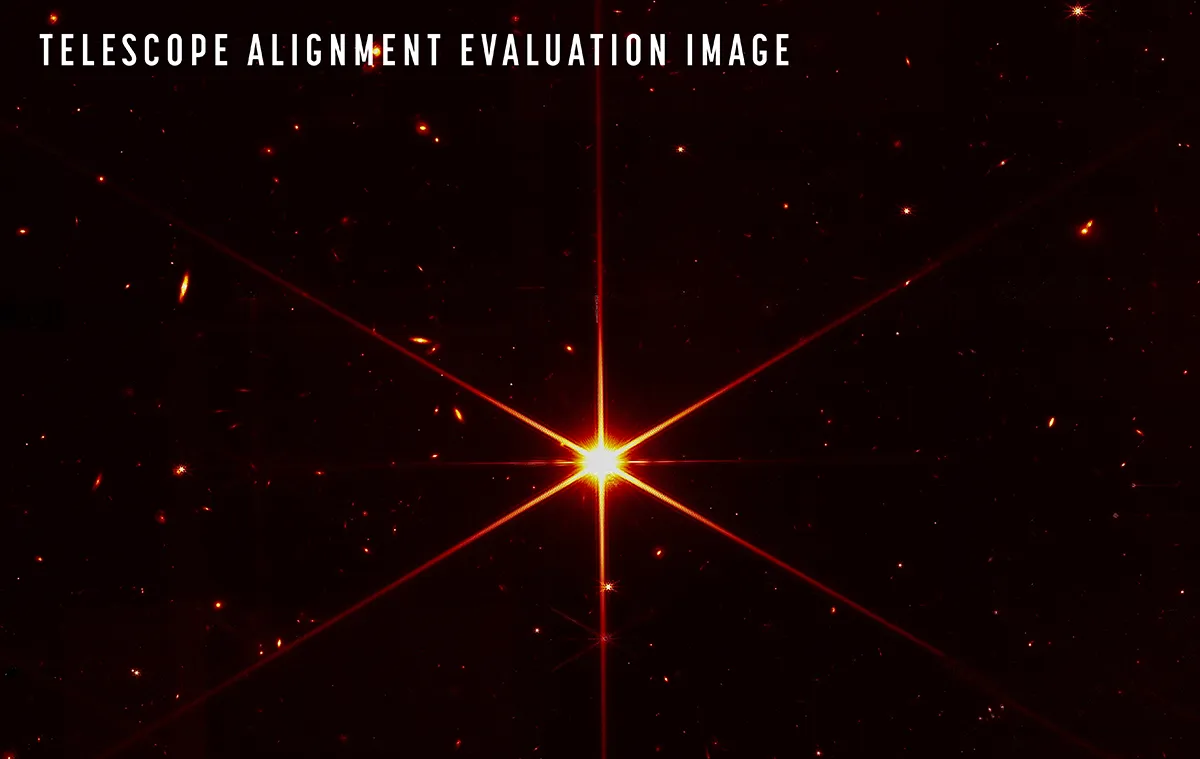
The milestone marked the end of a procedure known as ‘fine phasing’. JWST’s main mirror is made up of 18 hexagonal segments; to focus these the team pointed the telescope at a lonely star chosen to be easily identified, with few nearby companions.
They then adjusted each panel so that when combined, the 18 separate images were aligned into a single point of light, focused to within an accuracy of 50 nanometres – a fraction of the wavelengths of infrared light it will observe in.
Next, the team imaged the star with the Near Infrared Camera. Even though this was only meant to pick up the focused star, the telescope captured a scattering of background galaxies as well.
JWST's 18-star mosaic
The JWST team released an image in February 2022 showing 18 ‘different’ stars scattered across a black background.
In fact, the image - seen below - showed a single bright star in the constellation Ursa Major known as HD 84406.
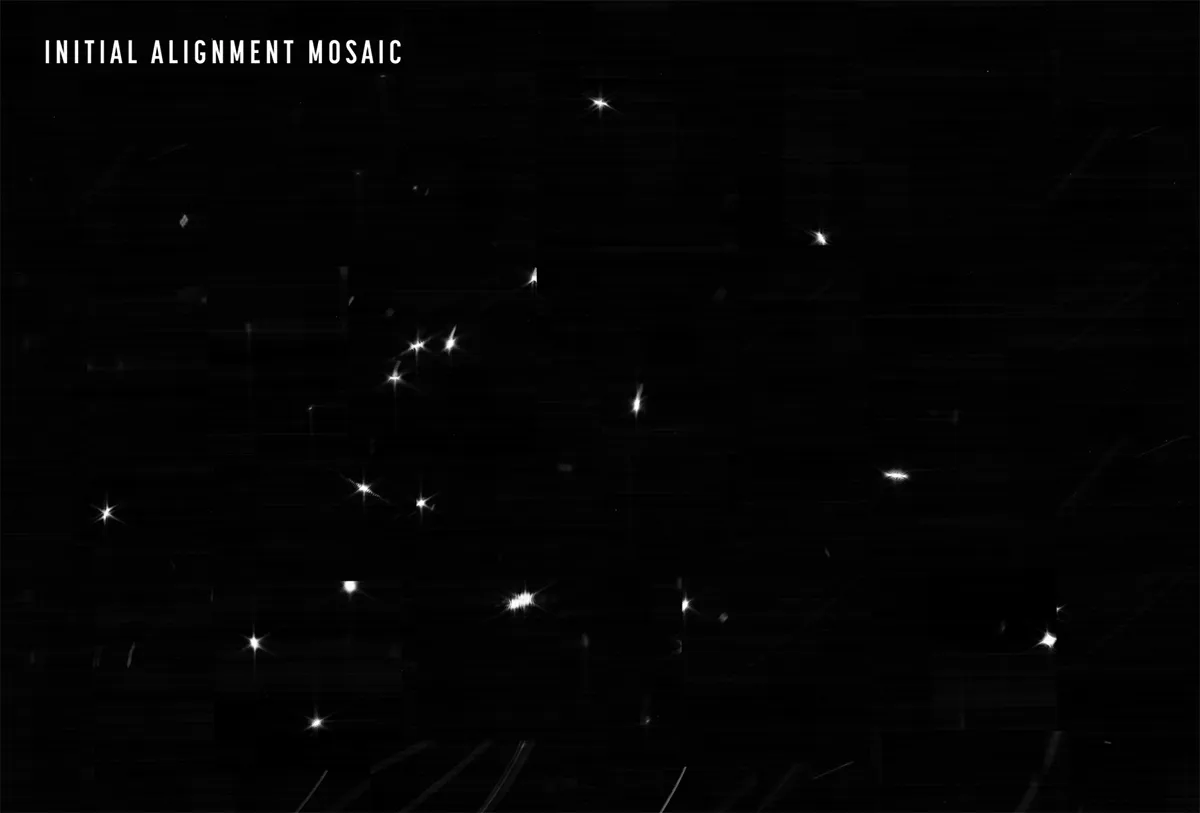
The star was seen in 18 different positions because JWST’s mirror segments were still in the process of being aligned.
This seemingly chaotic capture was a result of JWST's unaligned mirror segments reflecting light back into the telescope's instruments, and was a vital part of preparing Webb for producing beautiful images of the Universe.
"We have aligned and focused the telescope on a star, and the performance is beating specifications," said Ritva Keski-Kuha, Deputy Optical Telescope Element Manager for JWST.
"More than 20 years ago, the JWST team set out to build the most powerful telescope that anyone has ever put in space and they came up with an optical design to meet the science goals," says Thomas Zurbuchen, Associate Administrator for NASA’s Science Mission Directorate
What next for James Webb Space Telescope?
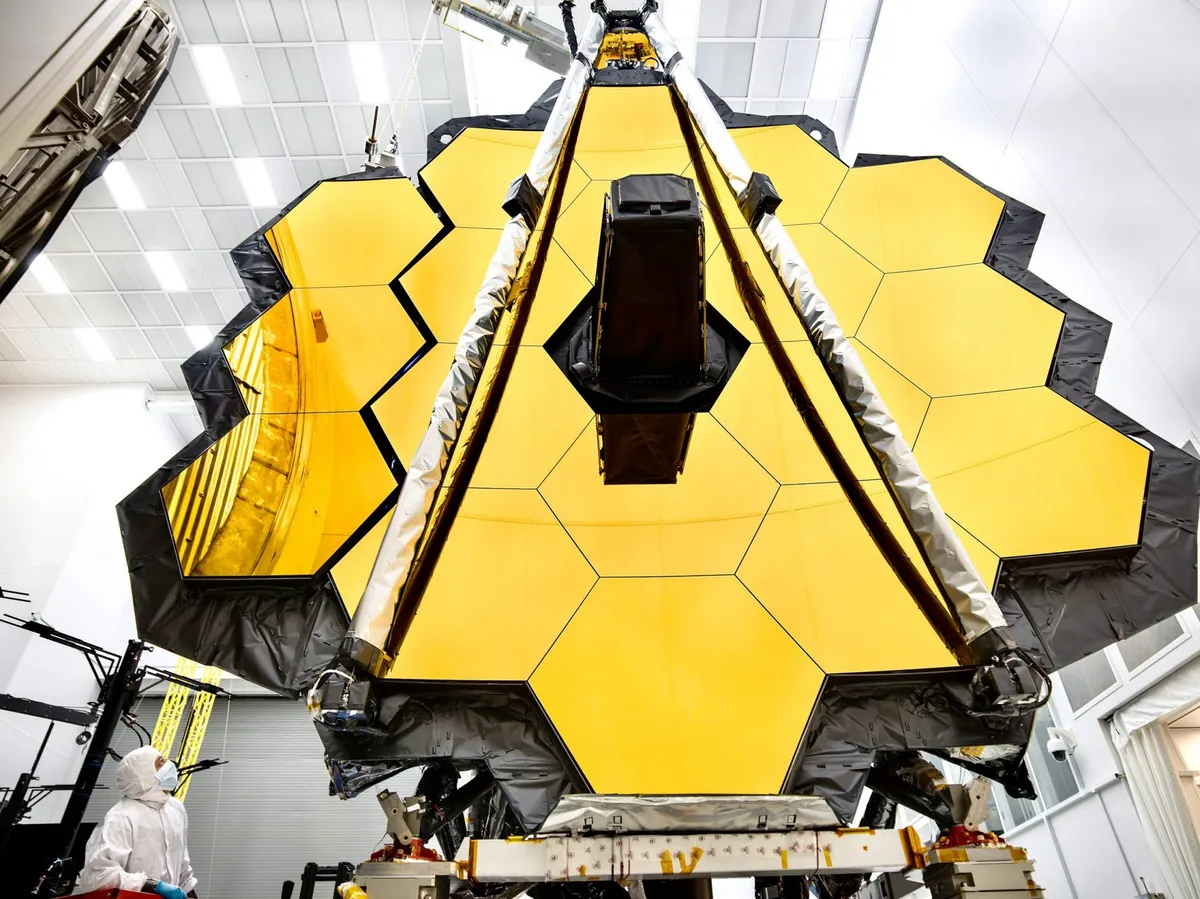
Compared to the previous infrared image of the region, from the Spitzer space telescope and WISE telescope, which showed an array of blobs, Webb’s image shows sharply focused galaxies that reveal structure in even these distant background sources.
With the exceptional resolution of JWST, we can piece together the life stories of these obscure galaxies.
Although we only have access to this single image, we know the camera will have imaged the field through many filters.
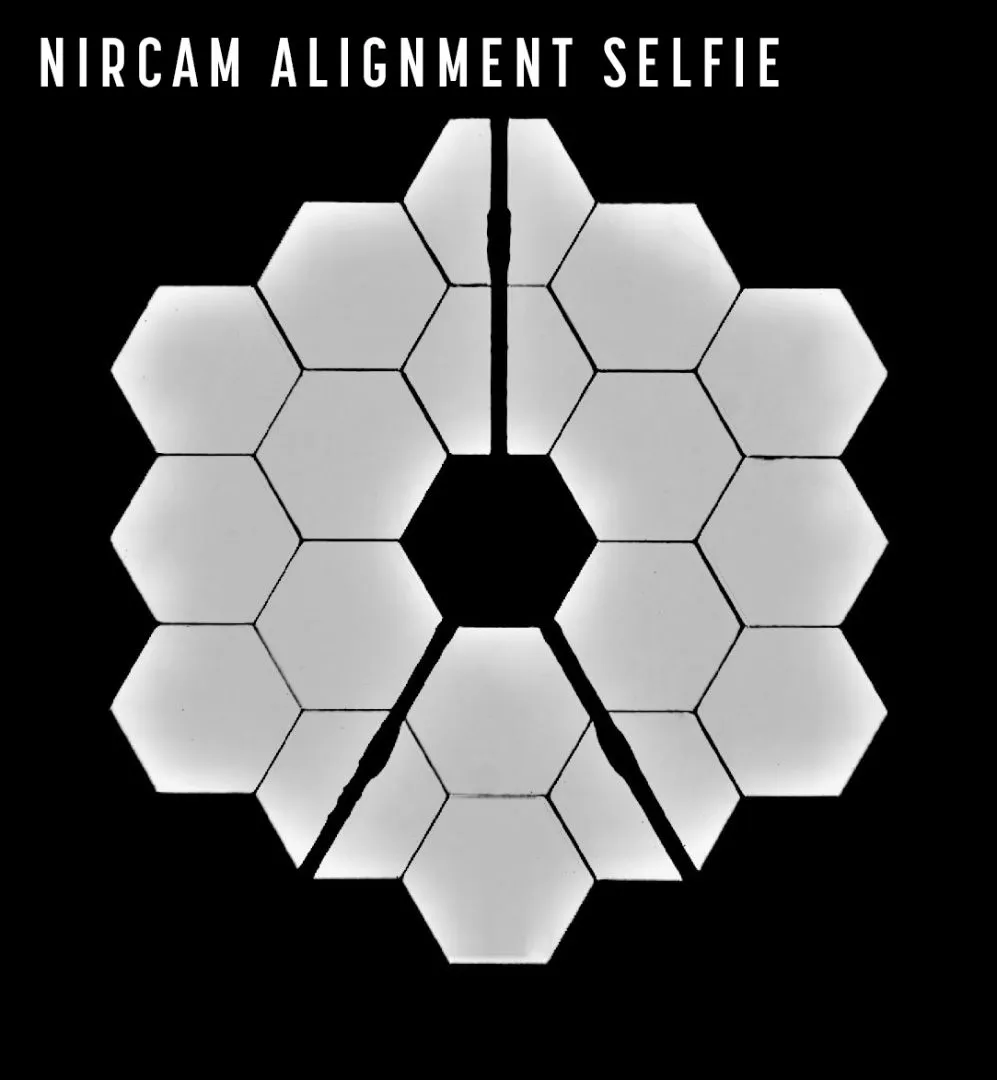
Looking at a galaxy’s brightness in each of these would allow us to make a good guess at its distance, and hence how far back in the Universe’s history we are seeing.
That’s not the point of these images, as more will be coming soon, but it’s a tempting idea!
What are your favourite James Webb Space Telescope images? Let us know by emailing contactus@skyatnightmagazine.com
